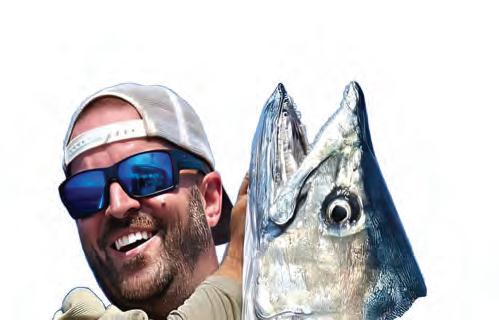

TIGHT BUDGET KINGS


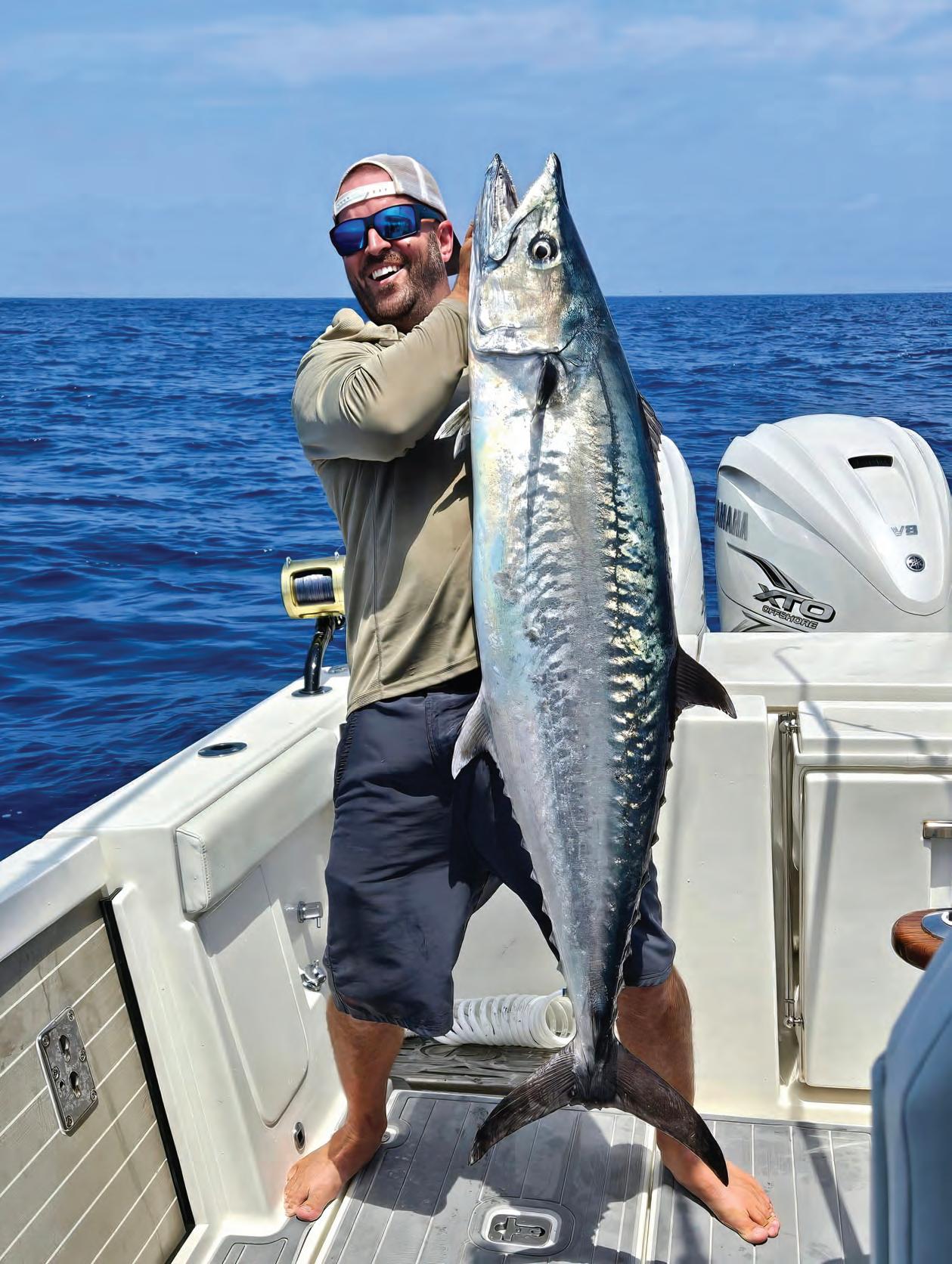

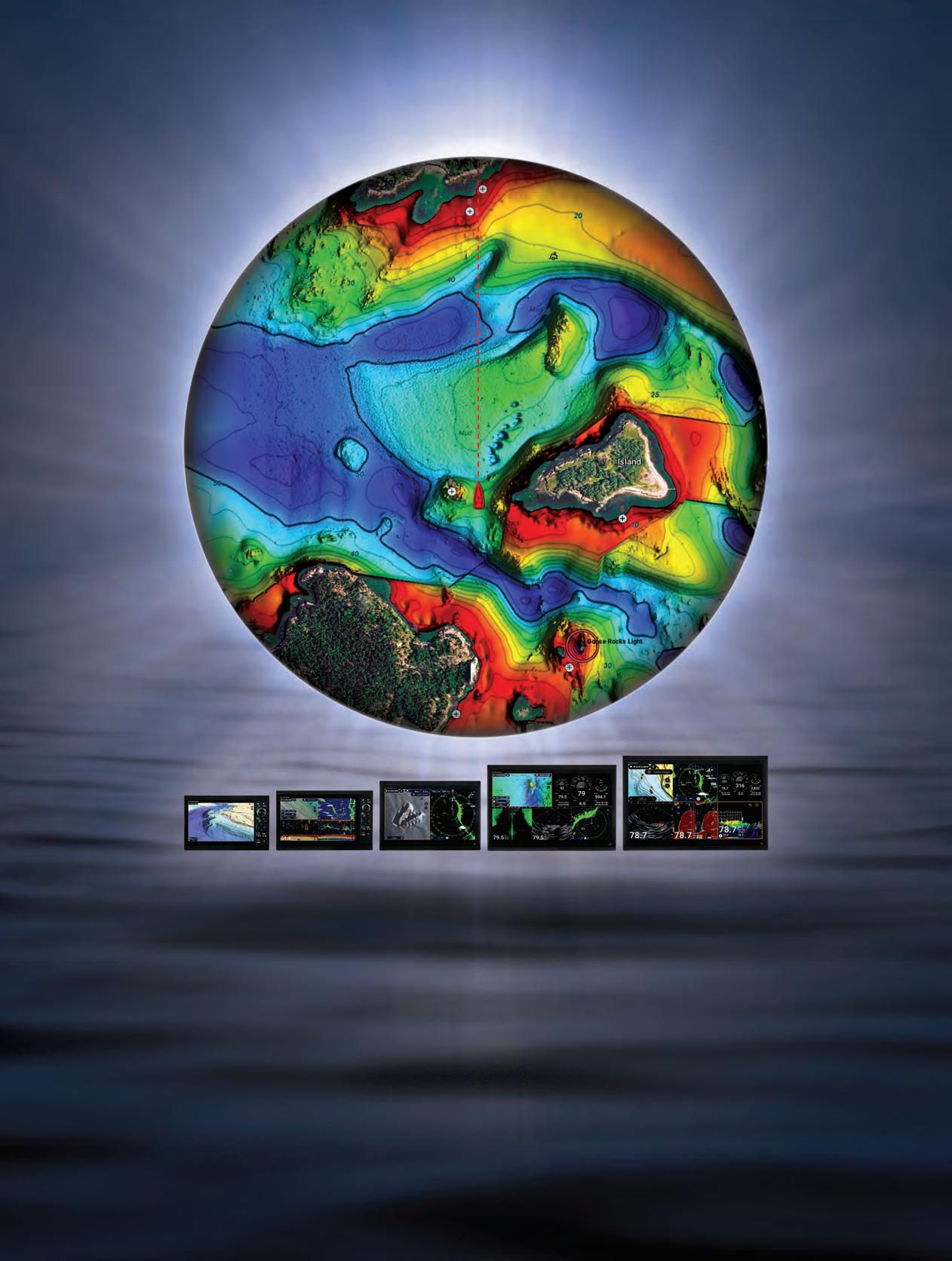
ou want new charts?
You got new charts! Explore the ocean with vibrant terrain & depth shading, using all-new TZ MAPS. Don’t just take our word for it. See for yourself. Scan here, and we’ll show you!











navigating peace of mind
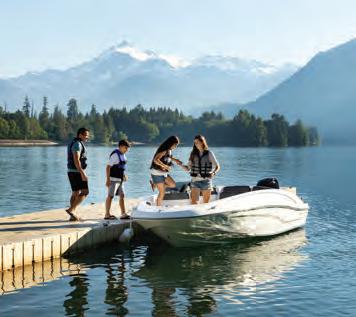






THE IMPORTANCE OF BOAT INSURANCE
Embarking on the open water is an exhilarating experience, flled with the promise of adventure and relaxation. Whether you’re a seasoned sailor or a weekend cruiser, protecting your vessel with proper insurance is not just a choice—it’s a necessity. Explore the reasons why every boat owner should prioritize boat insurance for a worry-free voyage.
Unpredictable waters
The open water can be unpredictable, with unexpected storms, collisions, or other potential accidents. Boat insurance can give you fnancial protection if there is damage to your vessel, providing coverage for repairs or replacement.
Damage and injury
Accidents on the water can result in damage to other boats, docks, or even injuries to passengers. Boat insurance offers liability coverage, which can pay for damages or injuries you’re liable for while boating, up to specifed limits, and lawsuit costs if you’re sued. This includes damage you cause to another watercraft or if someone on or near your boat is injured and you’re found to be legally responsible.
Theft and vandalism
Unfortunately, boat theft and vandalism are realities that boat owners face. Boat insurance has comprehensive and collision coverage that can protect you against events outside of your control, including theft and vandalism.
Incurred medical payments
Accidents on the water may lead to injuries for you or your passengers. Boat insurance offers a range of optional medical payments coverage limits, helping to cover medical expenses if you are in an accident or someone is hurt on your boat, regardless of fault.
Peace of mind for fnancing
If you fnanced the purchase of your boat, most lenders require insurance coverage to protect their investment. Having boat insurance not only fulflls these requirements but also gives you peace of mind knowing that your fnancial interests are safeguarded.
Navigational fexibility


Some water municipalities and marinas may require proof of insurance for docking or accessing certain areas. Boat insurance allows you the fexibility to explore different destinations without worrying about entry restrictions.
Emergency towing and assistance
Progressive boat insurance can include optional Sign & Glide® On-Water Towing coverage. If your boat is disabled or breaks down on the water, Sign & Glide® pays for on-water towing, jump starts, soft un-groundings, and fuel delivery.
Wreckage removal
If your boat sinks, Progressive boat insurance will cover the cost of removing your boat from the water (if removal is legally required).
Investing in boat insurance is not just about protecting a valuable asset; it’s about safeguarding the memories, experiences, and joy that come with your on-water adventures. Don’t let unforeseen circumstances disrupt your journey—navigate with confdence, knowing that Progressive boat insurance has you covered. Ensure a smooth and worry-free voyage, because when it comes to your boat, peace of mind is the ultimate luxury.
Scan to get a quote in as little as 4 minutes
learn more.




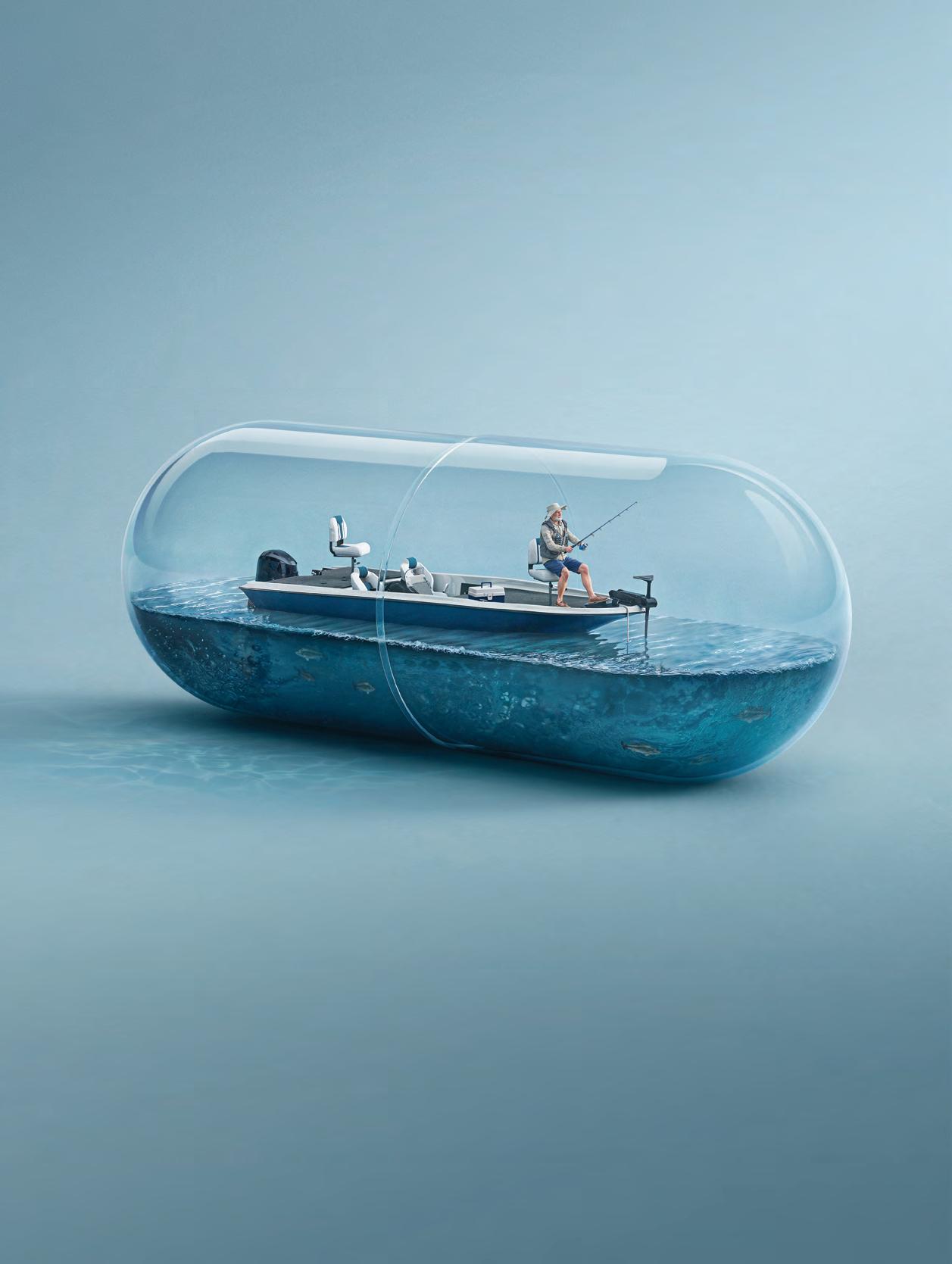
















FATHER’S DAY: THE PERFECT TIME TO FISH WITH YOUR KIDS
THATCH MAGUIRE, EDITOR AT LARGE
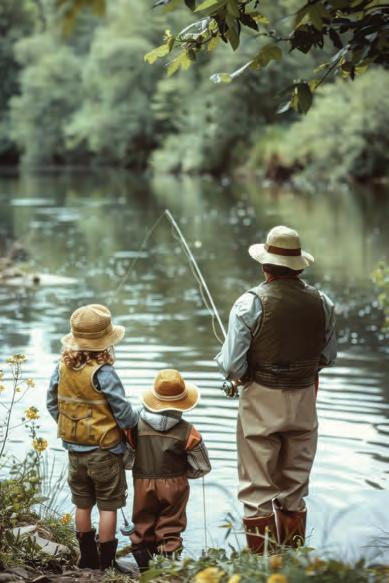
Father’s Day is one of the best opportunities to take your kid !shing.
It’s a celebration of the powerful bond forged when dads pass down the timehonored tradition of !shing, a tradition that stretches back thousands of years. While !shing once put food on the table out of necessity, today it still feeds something deep within us. at ancient connection to the water lives on in every angler, whether they realize it or not.
Inviting your son or daughter to !sh on Father’s Day regardless of their age makes a timeless statement. It bridges distance, mends di erences, and rea rms love in a way few other gestures can. Even if the day ends without a single bite, the act of !shing together creates a bond that words can’t express. It’s not about the catch. It’s about the connection.
ere are countless lessons a father might teach a child, but carving out time to share a quiet day on the water—free from the noise and distractions of modern life is one of the most meaningful. By saying, “Let’s !sh together today,” you’re also saying, “Let me share who I am with you.” And that’s a gi no one forgets.
Don’t have a son or daughter? No problem. Take any kid !shing this Father’s Day. Whether it’s a neighbor, a niece or nephew, or a friend’s child, the impact is the same. You’re passing on something real, something rooted in tradition, and something that could change a young life forever.
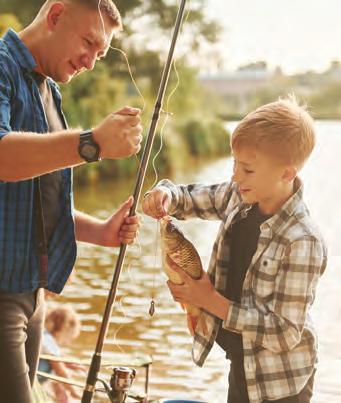
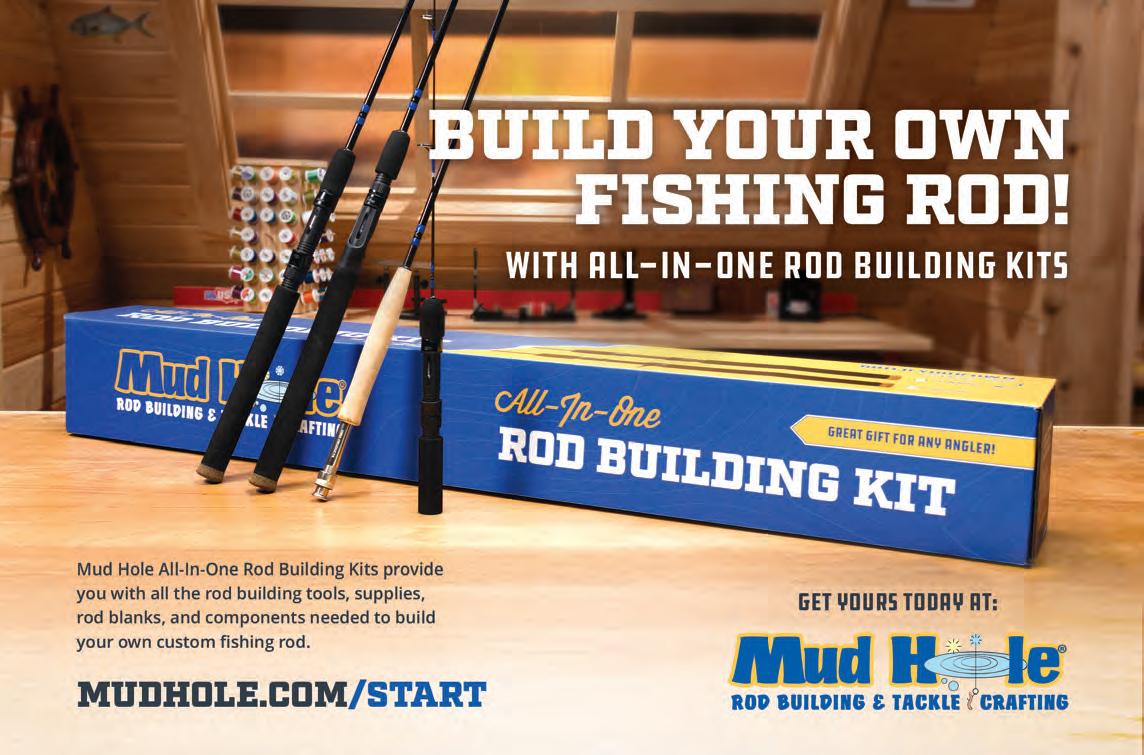

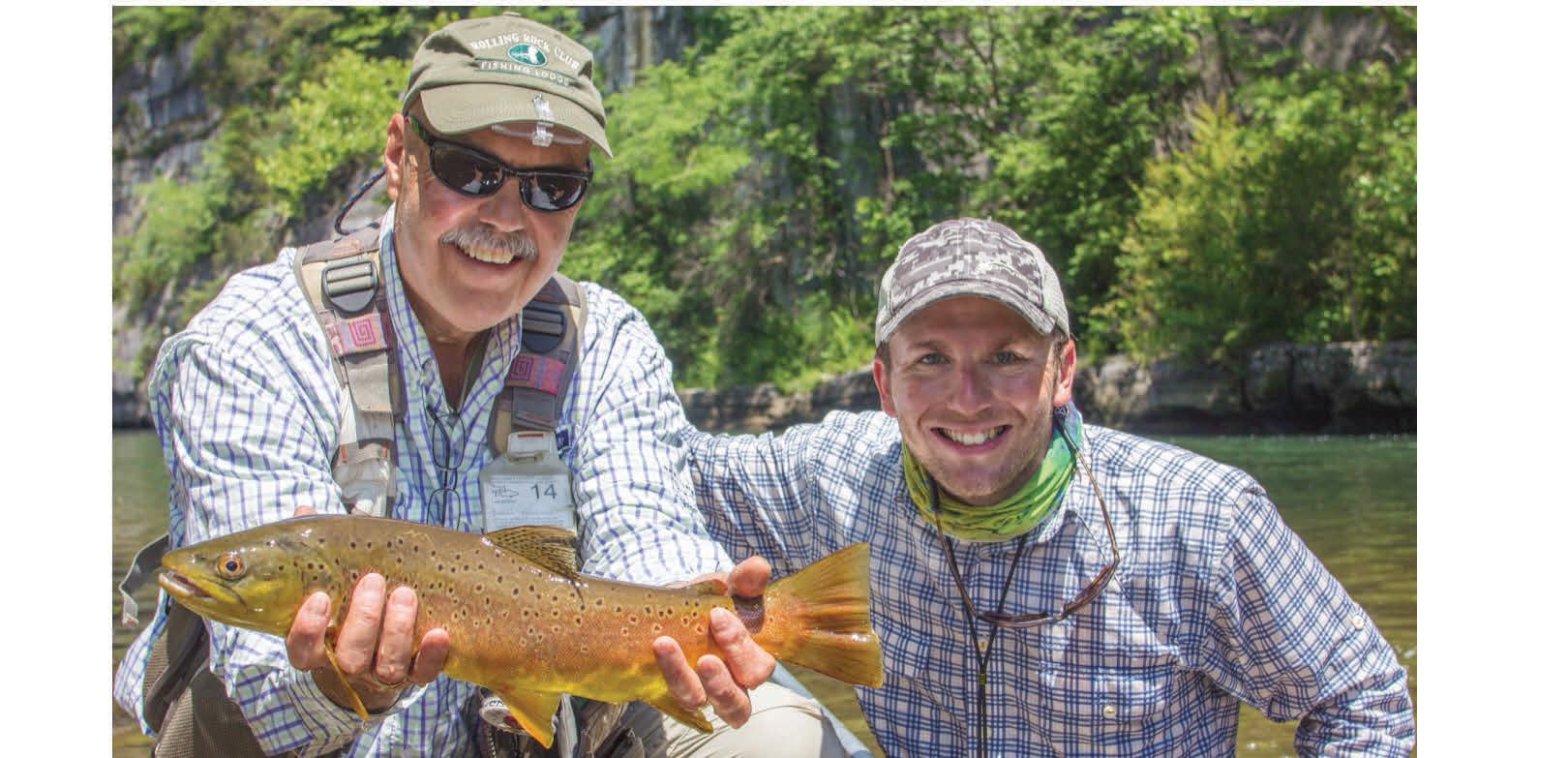






KINGFISHING
ON A SHOESTRING BUDGET
By Capt. Steve ompson
Targeting king!sh during their annual migration season o Florida’s east coast is a predictable event that coincides with the annual migration patterns of the Atlantic stock of king!sh. During the summer, anytime from midMay through August, when the water is warm enough for the kings to stick around, we all have a great chance of catching a tournament class king!sh, at almost anyplace we decide to !sh.
King!sh can be caught anywhere from the mouth of an inlet, on out to 200 foot depths, and that means that almost any seaworthy vessel can, and does, go a er these !sh during the “mostly calm” summer days.
Everyone has heard about the GJKT tournament winner that Fred Morrow caught at the tips of the north rocks, or Bob Johnson on his Traveler who won the aggregate, with two nice !sh, also right o the beach. What do these teams have in common? ey won in small boats with very little overhead, with very short runs to their !shing grounds. But they did their homework and had a plan, and went straight to where they were going to !sh. Because let’s face it, the small boater isn’t going to run all over the ocean chasing !sh that have already been caught. And those are not the only examples, this same scenario takes place every year
in tournaments up and down the Atlantic coast.
Another way to !sh on a budget is to not get caught up in the latest and greatest gear. Sure, you need quality equipment, but one can good used reels from friends, who are upgrading, or from yard sales or even at swap meets at your local o shore club.

As far as rods go, if you know what “feel” you like on your rods, you can !nd o name rods at sidewalk tent sales at your local tackle store, that perform as well as a custom rod, for a fraction of the cost!
To avoid buying that expensive bait, become pro!cient with a cast net! Kings get fat and happy on a steady diet of “pogies”, or menhaden found along our beaches. You need a heavy fast sinking net to have all the bait you want for a day’s !shing. No pogies, you say? Don’t worry, many king!sh over the years, have fallen to other baits than just a pogy. A pound of shrimp on tournament day could very well be a day saver. Croakers are great king baits, as well as blue runners and blue!sh. Ribbon!sh can also be used but are best caught a few days before and brined so they are easily trolled. If you like !shing the Party Grounds always have some sabikis on board. ese are small feathers on small hooks on a special rig that will catch fresh sardines and cigar minnows on most of the o shore reefs and wrecks.
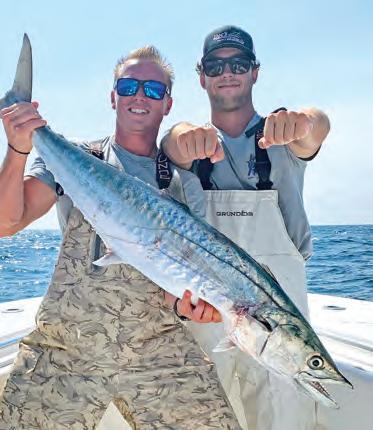
Don’t be intimidated when you sign up to !sh any tournament. You have the same chance to catch a tournament winning king!sh as the next guy. And you do not have to drop big bucks to do so. Just do your homework, pre-!sh as much as possible and, come tournament day, have a plan and stick to it…and we’ll see you at the weigh scales!
Capt. Steve ompson is Chairman of Jacksonville Marine Charities / Greater Jacksonville King sh Tournament and a 40-year successful veteran of competitive king sh tournaments all over the Southeast. Contact him at (904) 251-3011 or email: gjkt@king shtournament.com.
Command The Water With Lowrance & Simrad
Whether you’re chasing trophy fish or charting your next offshore course, your time on the water deserves the best in navigation and marine technology. Defender brings you UNBEATABLE PRICES and EXPERT SUPPORT on Lowrance and Simrad electronics—trusted by professionals and weekend warriors alike.

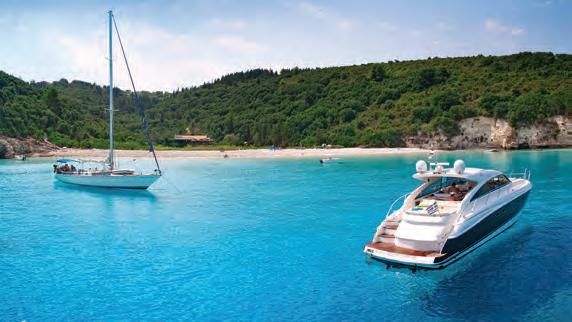
The choice for powerboaters and sportfishers. Get crystal-clear sonar, radar, and navigation that keeps you locked on target.

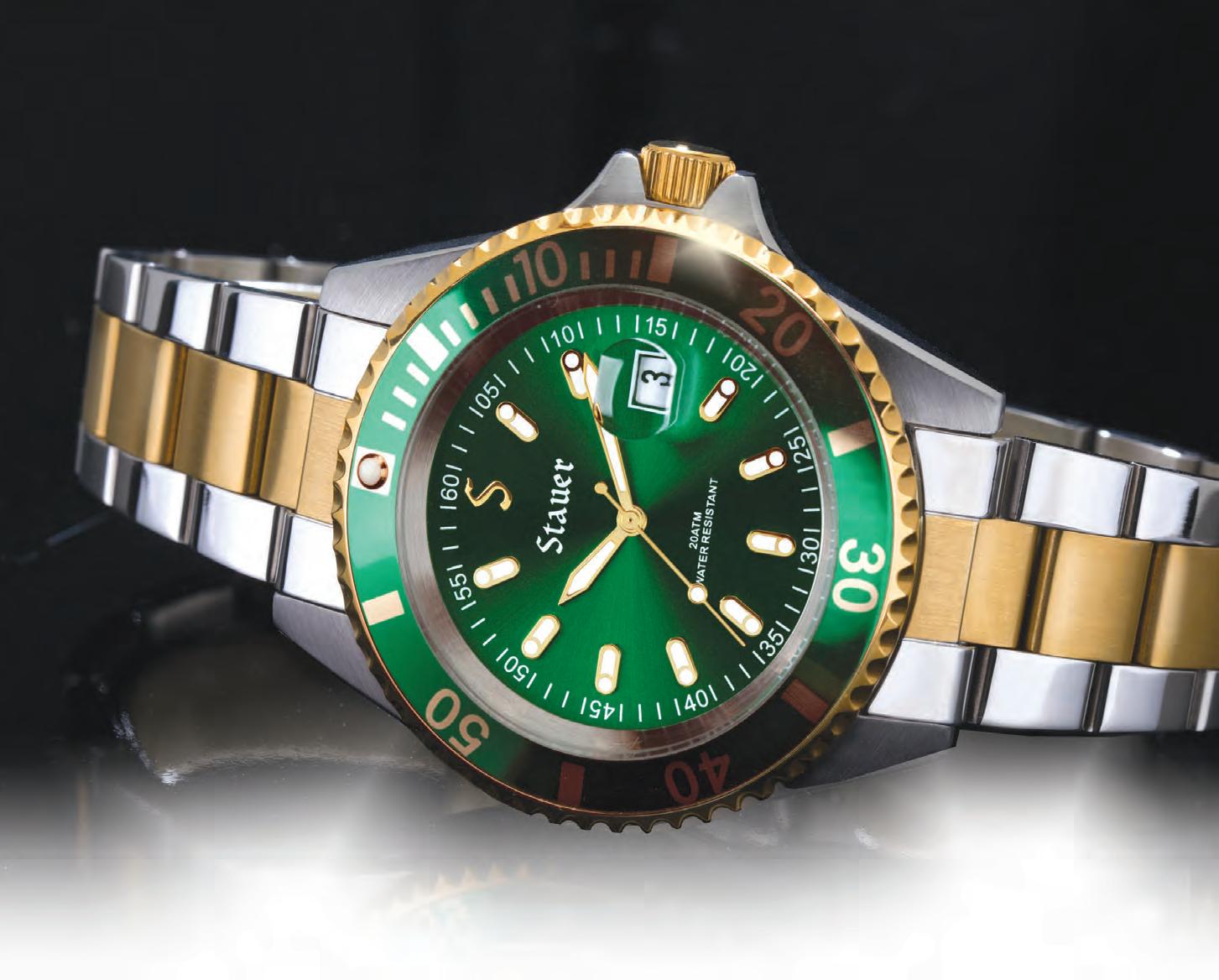
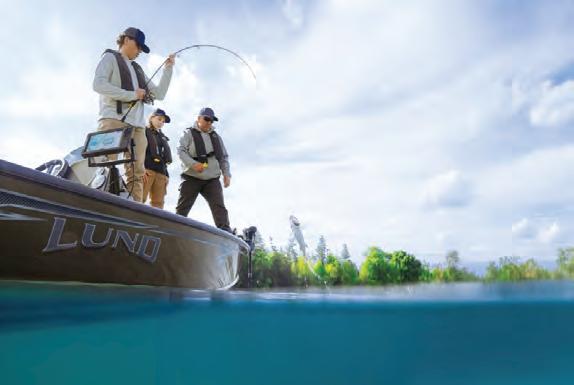




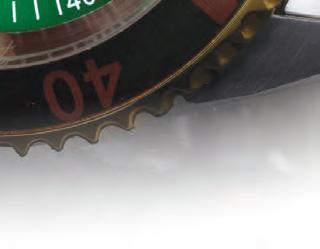
–– George Thomas, Noted watchmaker & historian

Greenlight to A Deep Dive Without Going in the Red


Every year in Basel, Switzerland, the world’s best-known luxury watchmakers gather to display their new timepieces. It’s a great event for spotting timepieces that standout–– in performance and in personality. We saw one impossible to ignore: a precision dive watch with an arresting green dial. But we also saw the five-figure price tag and knew we could bring our customers that exact same precision and stand out appeal for a whole lot less. The Stauer Evergreen Diver is that timepiece.
Built like a submersible battleship with a stainless steel case, caseback, and band, the Evergreen Diver is water-resistant down to 660 feet or 20 atmospheres, a feat facilitated by a hardened crystal and screw-down crown.
Green On Your Wrist AND In Your Pocket. You could pay an awful lot elsewhere for this verdant virtuoso, but the majority of the cost is in the big designer name upcharge. We think those guys are all wet. This is how you own a top-of-the-line dive watch without helping pay for some marketing guy’s yacht.


Satisfaction Guaranteed or Your Money Back. Wear the Evergreen Diver for 30 days. If you’re not completely happy, send it back for a full refund of the item price.
Limited Reserve. A watch of this caliber, with a price that won’t drag you under, takes 6 months to create and won’t stick around for long. Call today!


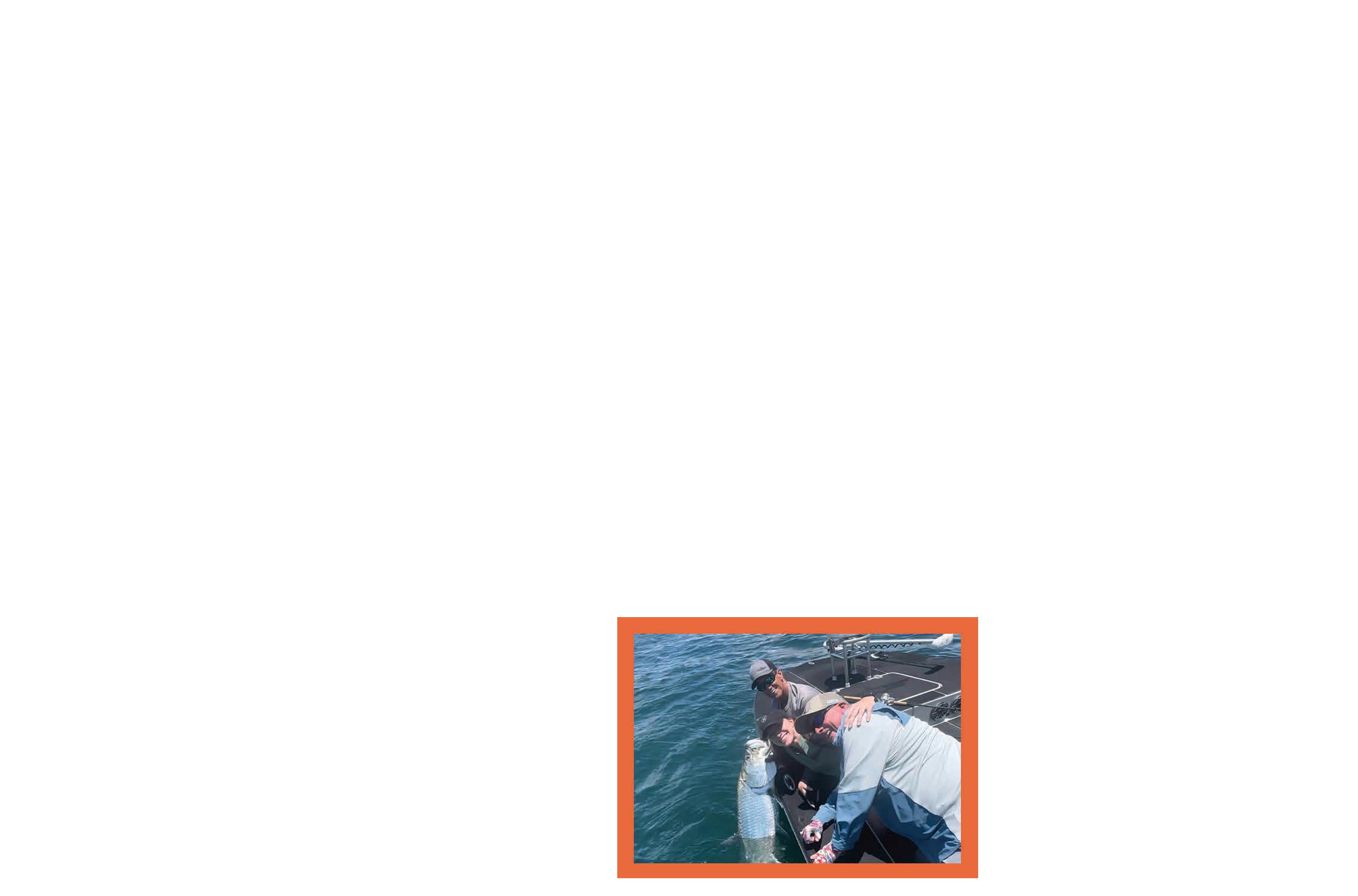
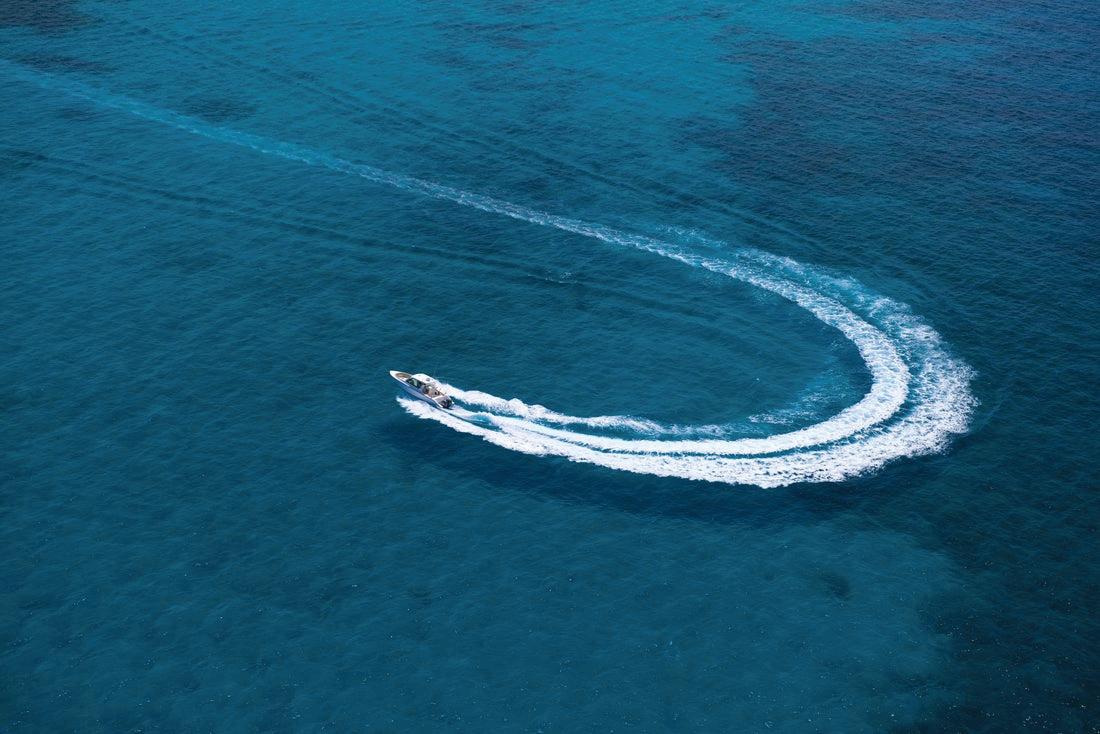
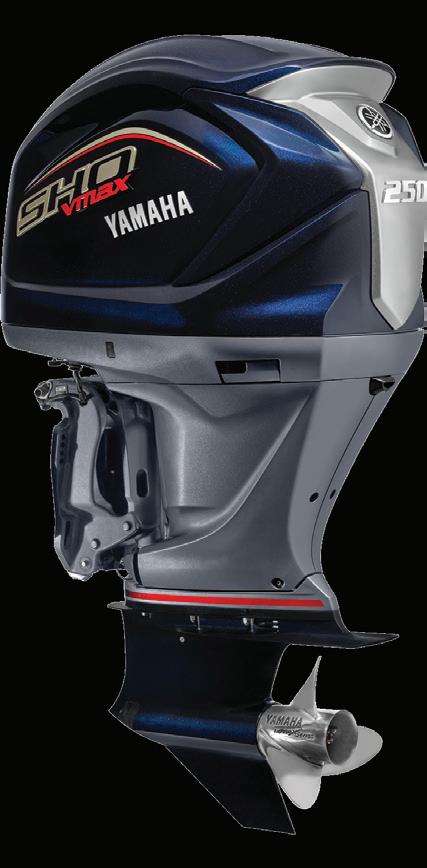
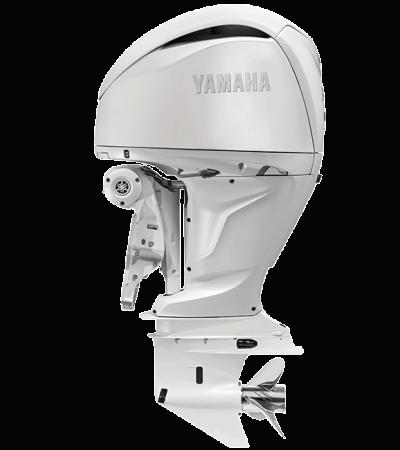

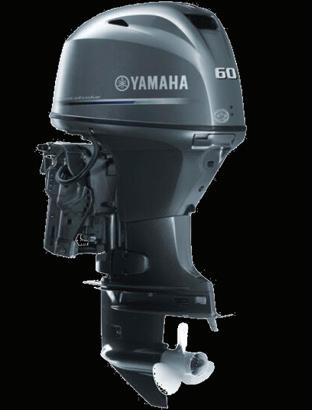

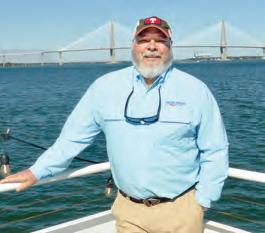
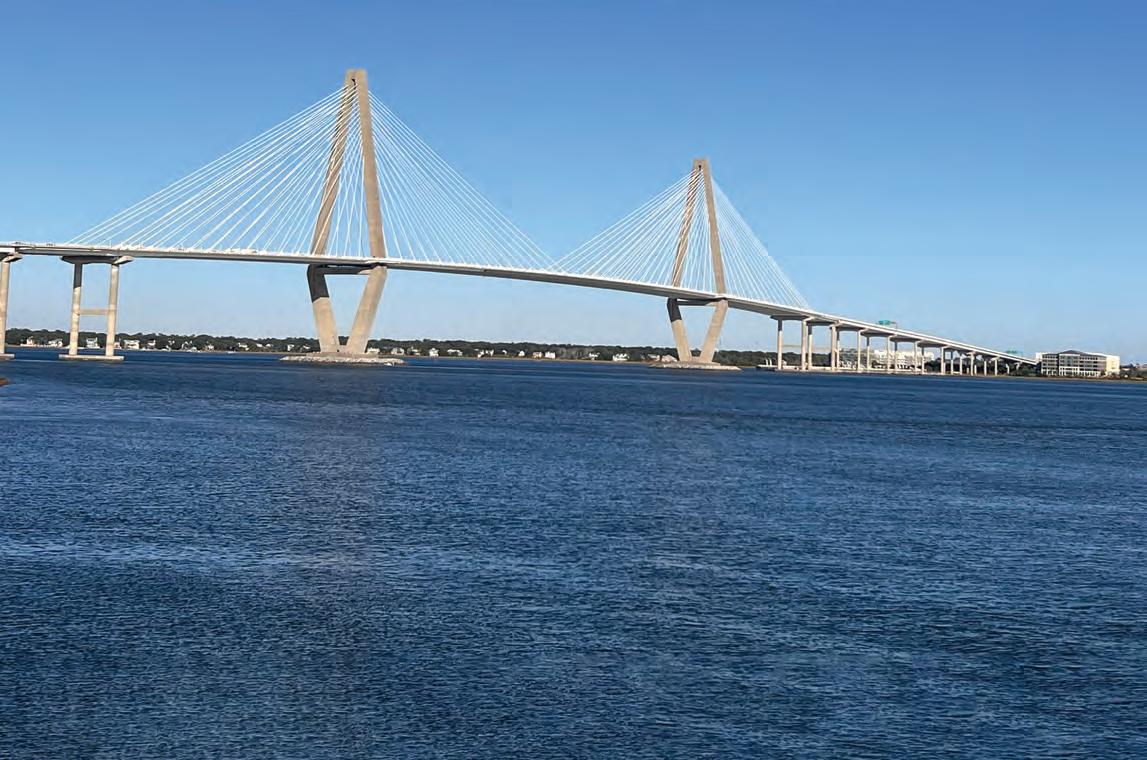

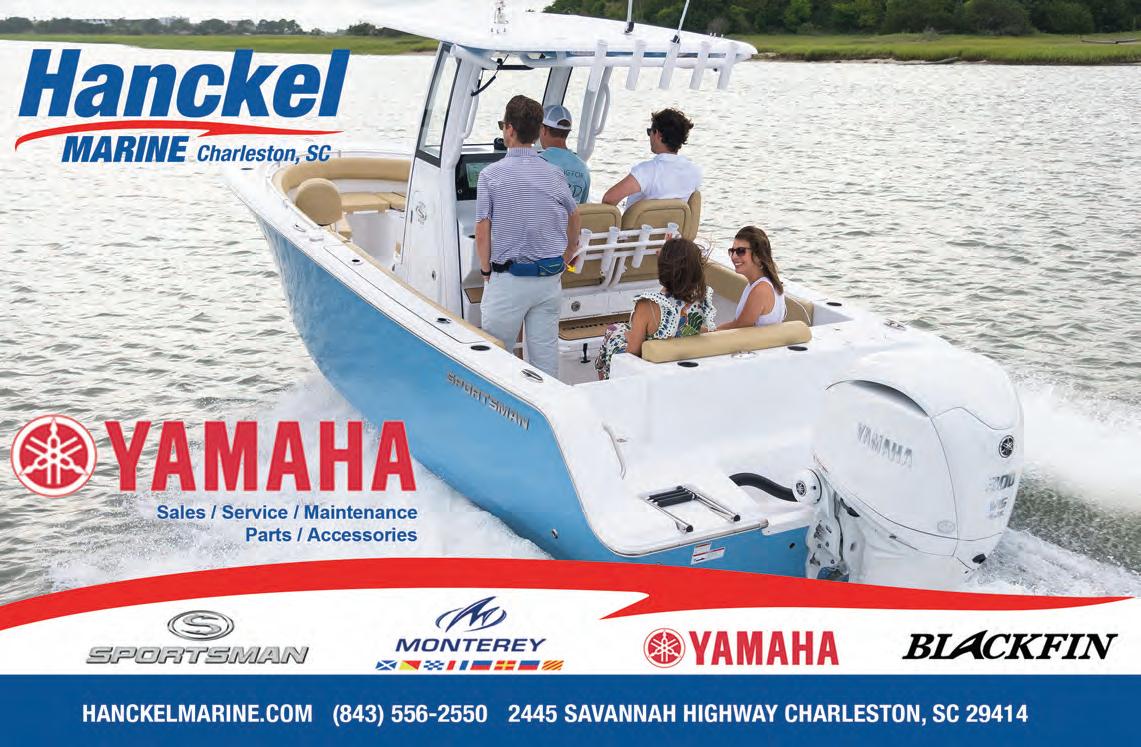
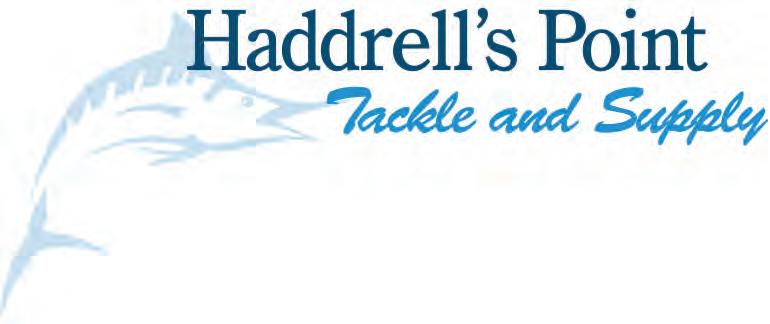
OFFSHORE REPORT
by Capt. Mike Able, Contributing Writer
Scenes from the 2025 East Cooper CCA Banquet
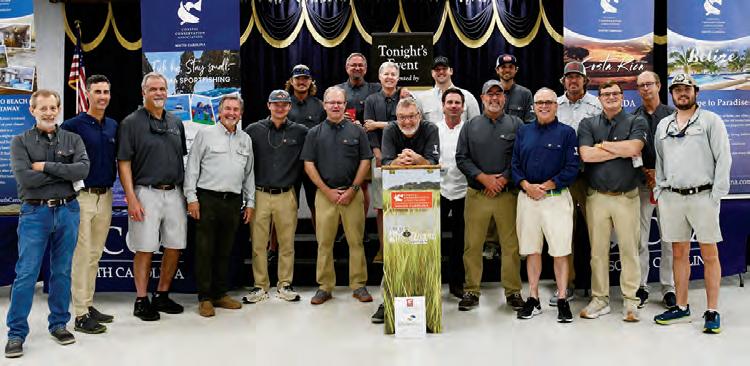

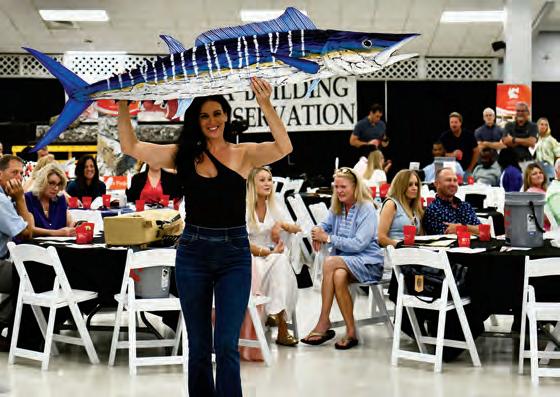
The Coastal Conservation Association (South Carolina) is an organization mostly made up of a volunteer group with the sole intent to help maintain a sustainable fishery along our coastline. I look at it as an investment into our business, but more importantly to my friends and family with generations to come, so they can enjoy the coast and the endless opportunities it can provide with a bountiful fishery. CCA SC has funded and accomplished several projects over the years including the Topwater Action Campaign, which is the oyster restoration and recycling of oysters, putting them back in our creeks and estuaries to provide habitat and water filtration. Another giant feat has been the incredible number of nearshore reefs along the SC coastline, involving the sinking of barges, tugs, and other structures to quickly form new habitat for species just a few miles off the coast. Without CCA I don’t see our fishery sustaining or improving. It’s a vital element that we (anglers and outdoor enthusiast) need to be part of, need to support and my business and my family will continue to support! Through attending banquets, becoming members, or even joining a committee in your local area we hope you will do the same!
Capt Mike Able
Haddrell’s Point Tackle & Supply • Since 1983 843-881-3644(Mt Pleasant) 843-573-3474(West Ashley)
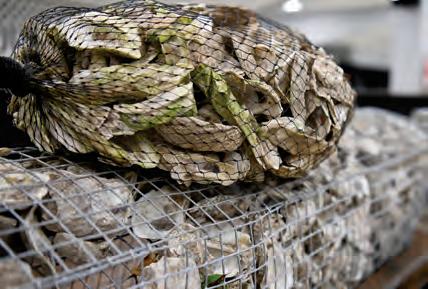
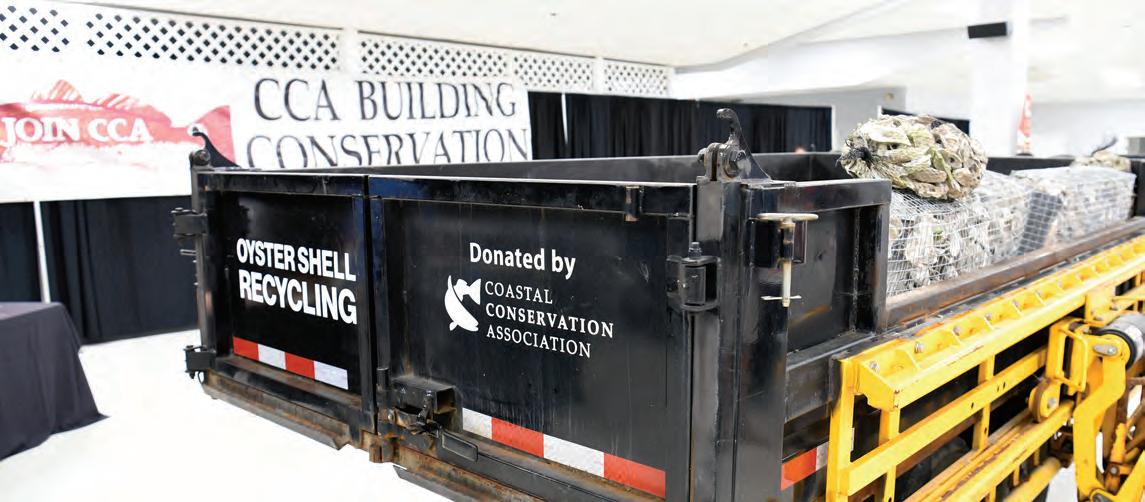
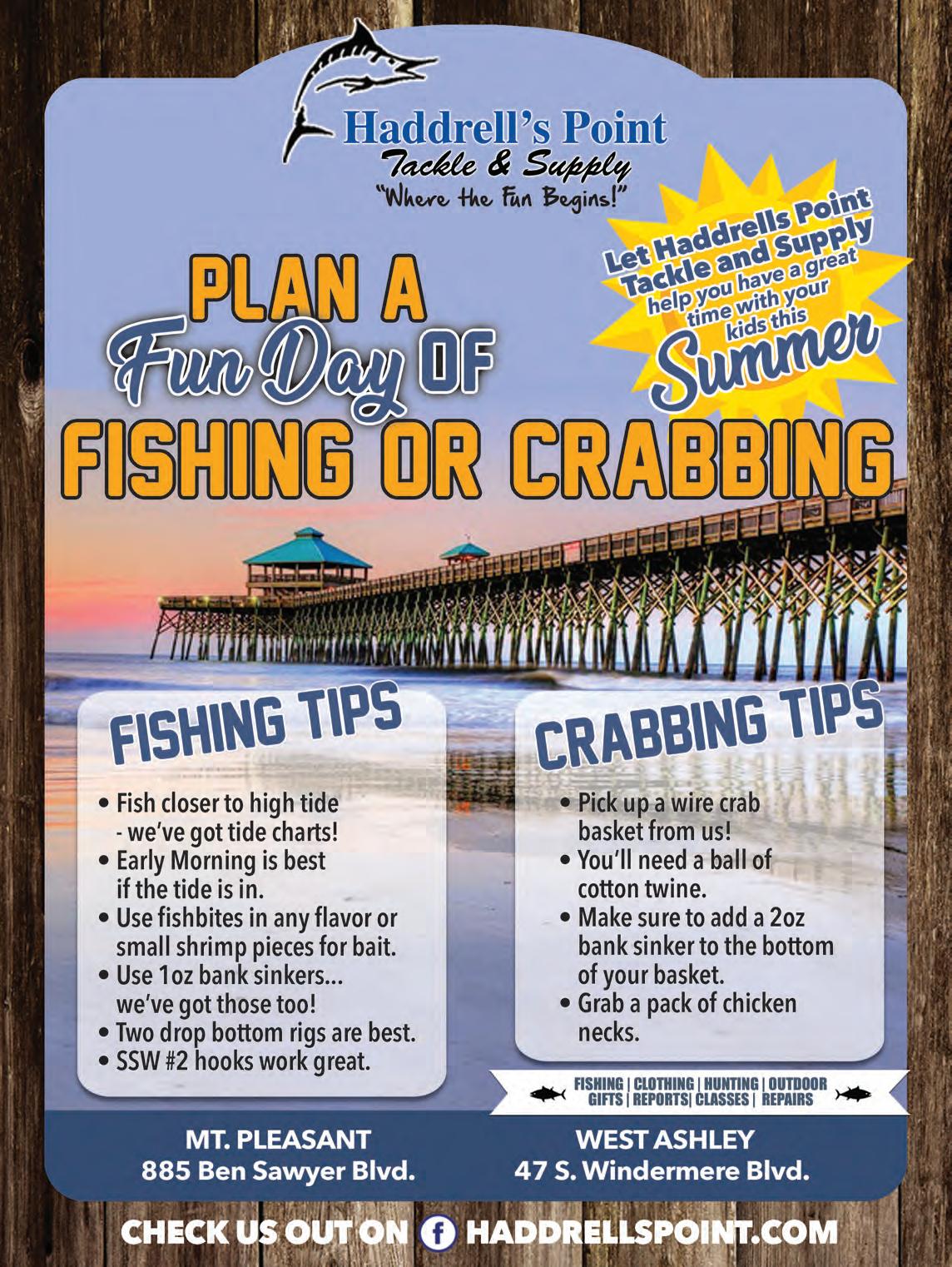
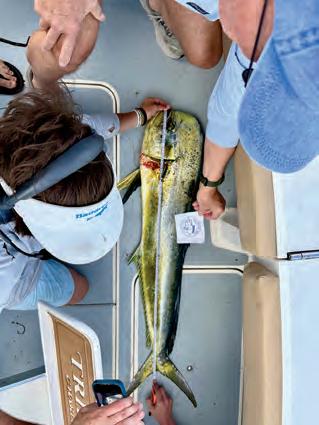
1st Place

Thomas Snyder TripleNet
50 Viking 4/24/2025
45"
Sara Beverly Double Trouble 2
34 Regulator 5/1/2025
44 1/16"
2nd Place
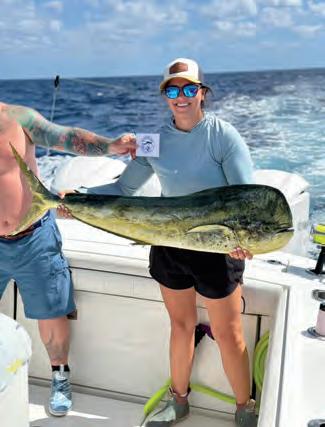


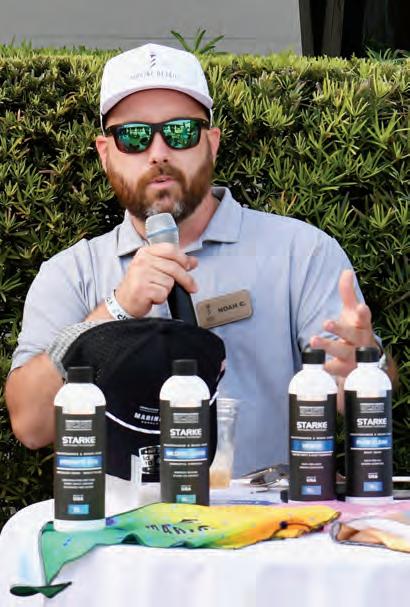
Noah Corcoran, Owner
Marine Detail Supply Charleston
7644 Southrail Rd Unit 400c, North Charleston 843-256-3383
MARINE DETAILING WITH NOAH
Introduction to New Column
by Noah Corcoran, Contributing Writer
Welcome to Detailing with Noah, a monthly column dedicated to all things marine detailing, brought to you by Marine Detail Supply Charleston. I’m Noah Corcoran, and I’ve had the privilege of working in the marine industry for years, honing my skills and passion for boats and their care. As the owner of Marine Detail Supply Charleston, I’ve seen firsthand the difference that high-quality detailing products and expert care can make, not only in the appearance but in the longevity of your boat.
Marine Detail Supply Charleston isn’t just another detailing shop. We are a dedicated partner to boat owners and professionals alike, providing the best tools, products, and knowledge to help maintain your boat in pristine condition. From ceramic coatings to pHbalanced soaps, our range of products is curated with both performance and protection in mind. Whether you're a seasoned boater or a first-time owner, our goal is to ensure your vessel looks great and lasts longer.
In each column, I’ll share tips, techniques, and product recommendations, along with a bit of my own experience in this industry. You’ll find insights on everything from everyday boat care to deep-cleaning methods, and I’m excited to help you keep your boat shining on and off the water. Stay tuned for expert advice, as well as news about the latest products and trends in the world of marine detailing.
**Quick Tip**: Always rinse your boat thoroughly with fresh water after a day on the water to remove salt and debris. This simple step prevents build-up that can cause longterm damage to your boat's surface and helps preserve the finish.
For more frequent updates, tips, and behind-the-scenes looks at the world of boat detailing, be sure to follow us on social media.
Thanks for joining me on this journey—let’s make your boat look its best!
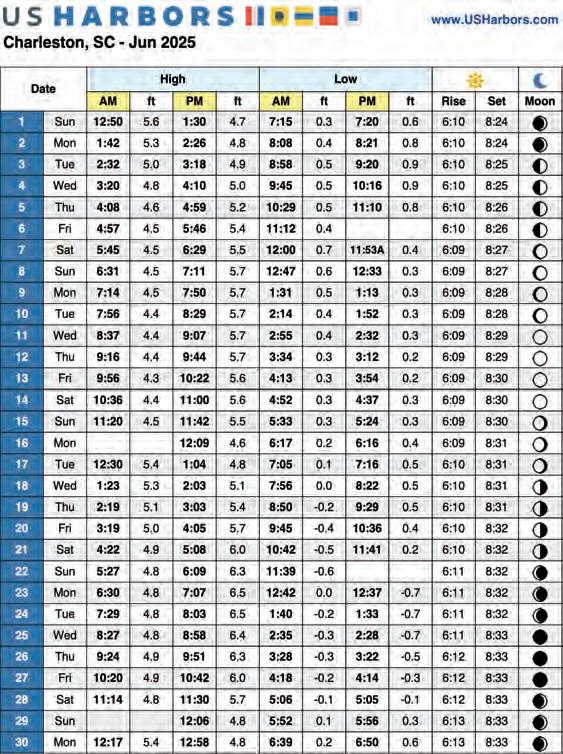

What is a Keeper?
by Jiggin’ Jerry, Contributing Writer
Every state in our country has fishing rules and regulations, and one of the most important things to know when you are traveling or local is your size limits and bag limits and the ability to identify the fish you are catching. Here in the Lowcountry when it comes to inshore fishing, most people target Red Drum, Spotted Seatrout and Flounder. Through the past 10 years, Sheepshead have become a very popular species and have made their way to the sport fish list and have been given a size limit and bag limit.
These size limits and bag limits that have been given in our state by SCDNR are to help with conservation efforts, which means these limits help keep species of fish from being overfished and mature breeding adults from being removed before they can spawn. I personally believe that some regulations are political and cater to big money, but that is another story. The regulations I am going to discuss are very important, and remember, if not followed, you can be ticketed and in some cases even arrested and your equipment confiscated.
I know this may sound harsh but believe me there are a number of habitual offenders that just don’t get the hint. I have personally seen locations completely destroyed and all the fish removed from their habitat because individuals that refuse to follow the law, so I recommend before venturing out on a fishing adventure, please find yourself a fish identification chart and local rules and regulations. After all, the most common answer for one of the most common questions—what are you fishing for—is “whatever bites” and that’s fine, but just remember you still need to know what you’re catching, especially if you plan on keeping it. So to help, I am going to supply a quick list of the size limits and bag limits for the most common fish caught while inshore fishing.
The size and bag limits in this chart are good until June 30, 2025, and are subject to change after that date by SCDNR, and emergency regulations could be implemented at any time. If you have any questions, or would like to know more regulations and information, I would recommend visiting the SCDNR’s website at www.dnr.sc.gov. If you are aware of anyone in violation of any of these regulations, please help by contacting SCDNR’s hotline at 1-800-922-5431.
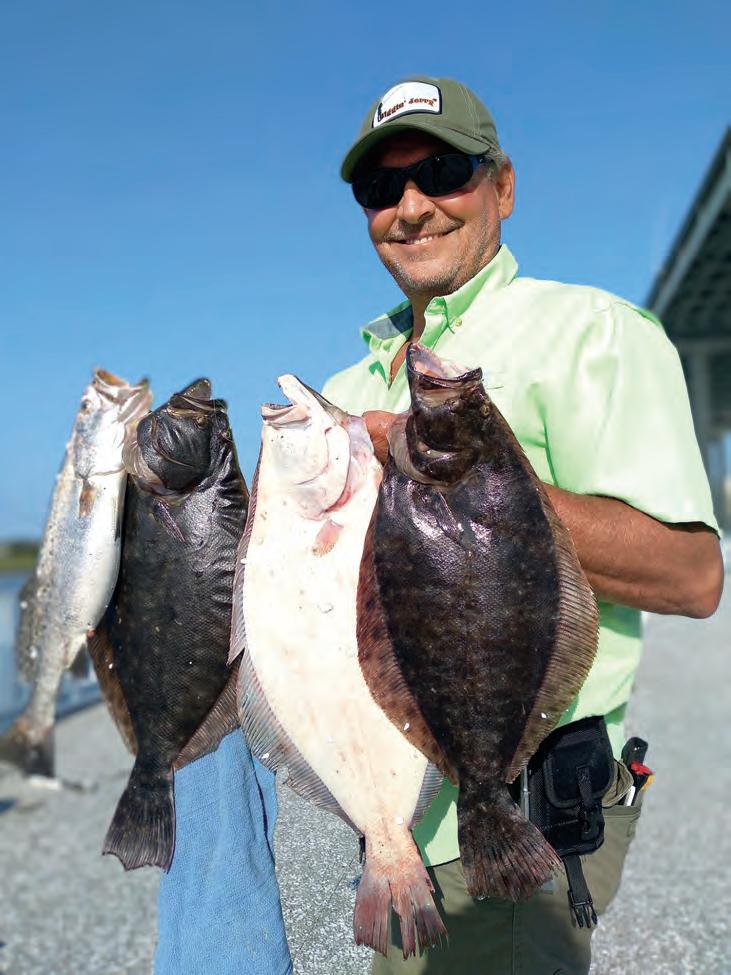
YouTube Channel Fishing With Jiggin Jerry or follow me on Facebook @fwjigginjerry
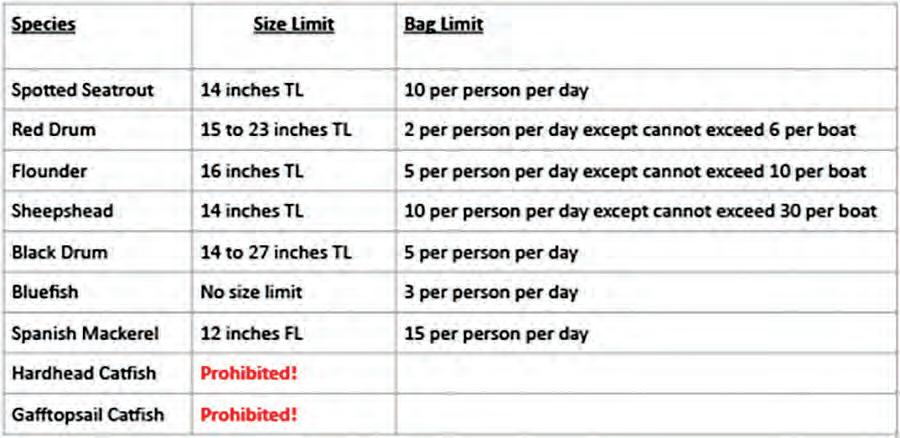
For those of you who are looking at the size limits and see a “TL” or an “FL” after the size and do not understand what “TL” and “FL” stands for, I will explain. “TL” stands for the total length of the fish when measuring. That means that the fish’s nose must be at the start of the ruler and measured all the way to the tip of the tail. “FL” stands
for the fork length. That means the fish’s nose must be at the start of the ruler and measured to the inside fork of the tail. If you still do not understand how these measurements work, please view the illustrations at SCDNR’s website.
I hope this helps with your next fishing adventure, and thank you for all your conservation efforts and following our state’s rules and regulations. Like I always say, good luck out there and have fun fishing!
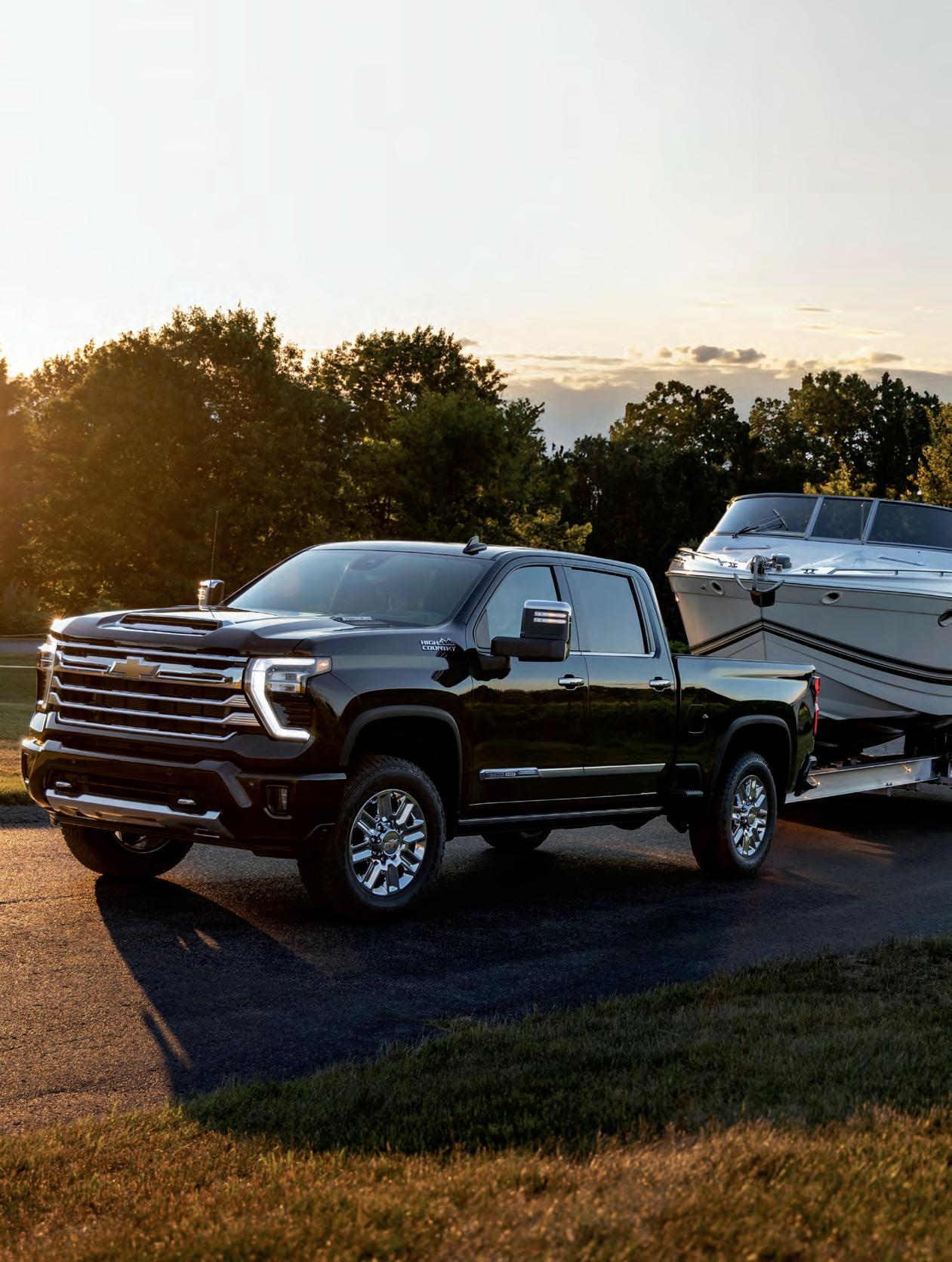


held at Colonial Lake. They had great weather and an even better turn out. The staff and volunteers really put on a great event in our marine community. in partnership with

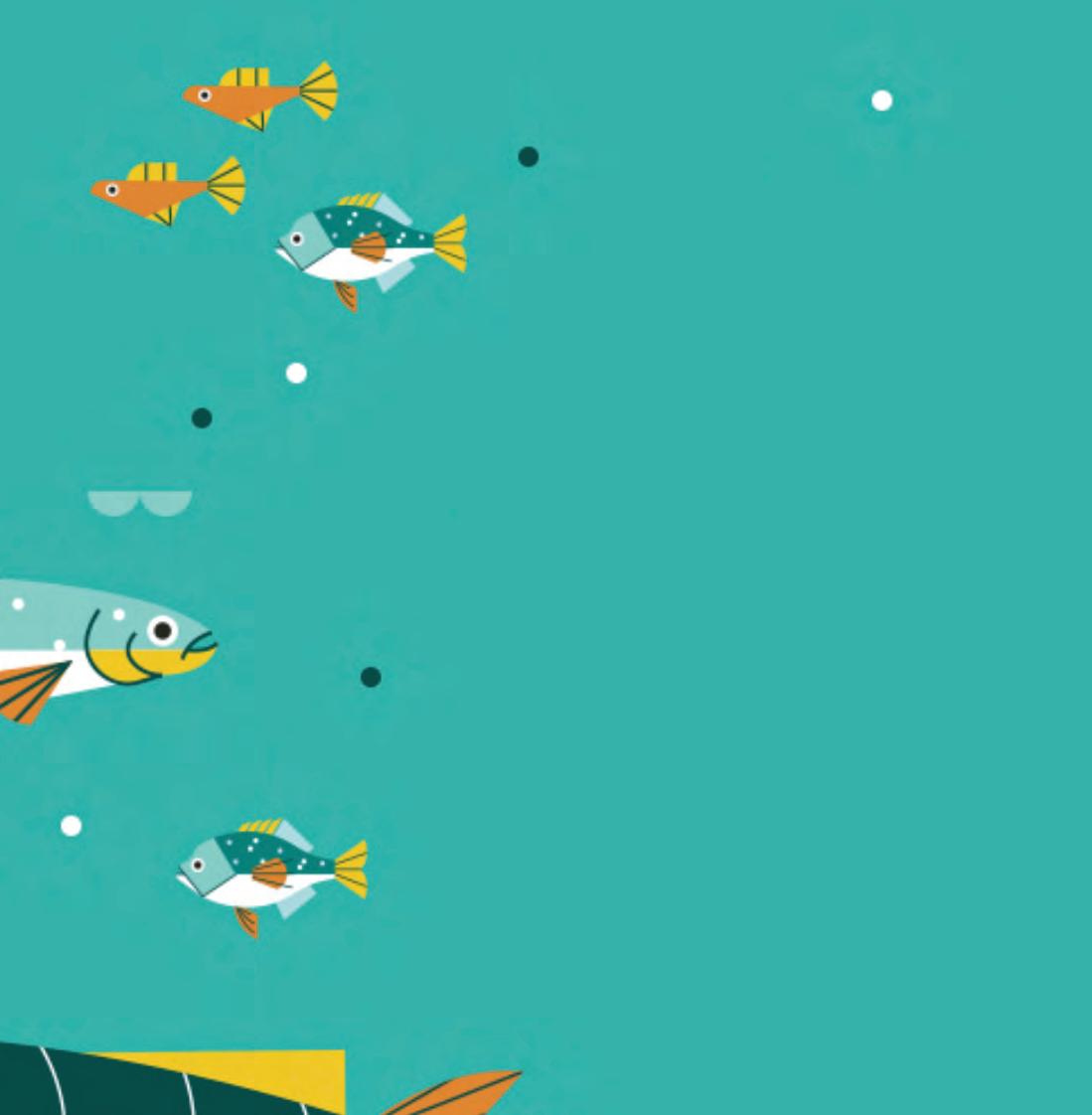
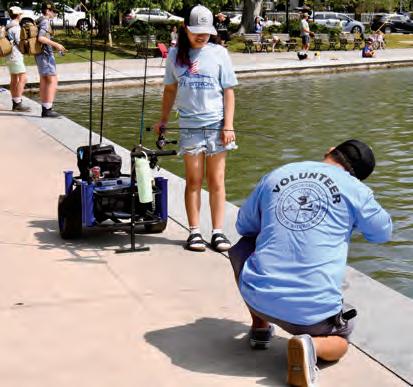
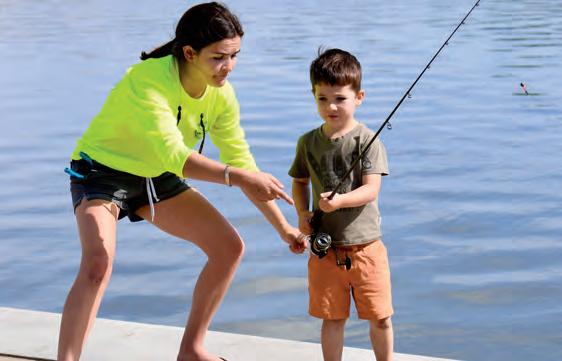
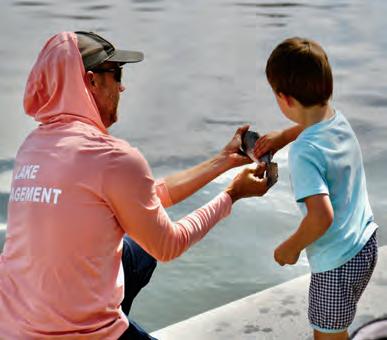
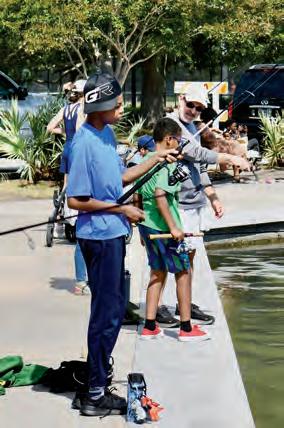
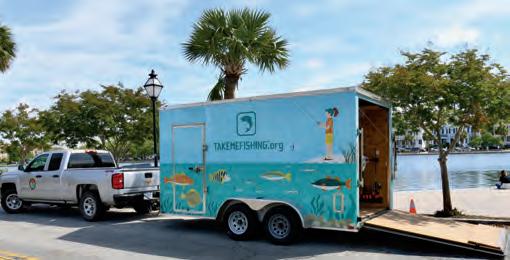

UPCOMING COASTAL EVENTS
June 5-7
Huk Charleston Cobia Cup & Huk Charleston Billfish Cup
Hosted at Saltwater Cowboys on Shem Creek
Registration and Information at www.charlestoncobiacup.com
June 18-21
Carolina Billfish Classic
Charleston Harbor Resort and Marina Info at www.fishbcbc.com
July 16-19
Edisto Invitational
Billfish Tournament
South Carolina Governors Cup • Edisto Marina Info at www.govcup.dnr.sc.gov
August 1 & 2
Lowcountry Tarpon Open
Hilton Head Island
Information and Registration at Eventbrite
September 13
Mt. Pleasant Pier
Cast Off Fishing Tournament
6 am-2 pm Charleston County Parks
Multiple Prize Categories • More info at wwwccprc.com
September 20
Folly Beach Pier
Cast Off Fishing Tournament
6 am-2 pm Charleston County Parks
Multiple Prize Categories • More info at wwwccprc.com
October 11
Mt. Pleasant Pier
Cast Off Fishing Tournament
6 am-2 pm Charleston County Parks
Multiple Prize Categories • More info at wwwccprc.com
October 25
Folly Beach Pier
Cast Off Fishing Tournament
6 am-2 pm Charleston County Parks
Multiple Prize Categories • More info at wwwccprc.com
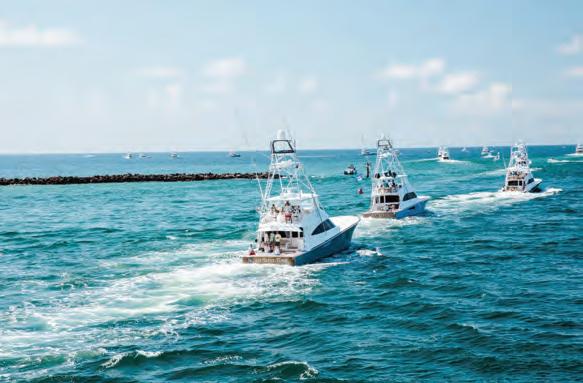
Submit your upcoming events or tournament Info to: brooks@coastalanglermagazine.com

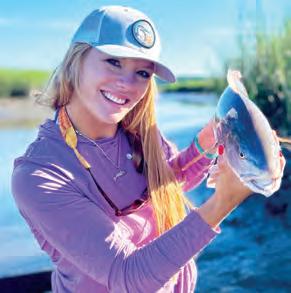
Sweet Sweet Summertime
By Katie Jo, Pluff Mud Princess Outdoors
SAnd if you’ve been cooped up all winter & spring waiting for the perfect time to get outdoors & go fishing… Well now is the time!
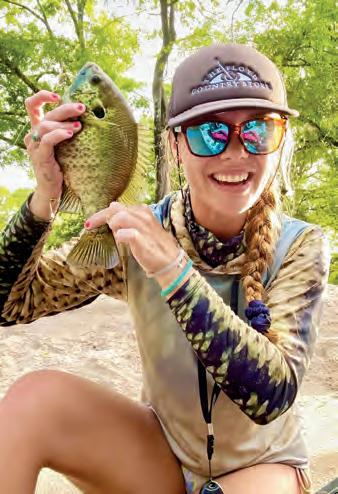
June is one of the best months to target a variety of species from Saltwater to Freshwater fish and for good reasons. That warmer weather brings with it warmer water temperatures as well as hungry, fired up fish looking for some action. And if you know the right time of day & the right baits to use, then you are sure to find that action!
I find the best time to fish in the warmer months is always going to be first thing in the morning and a few hours before Sunset. This is the period when fish are going to be most active & looking to feed while avoiding that scorching sun and the middle of the day when they tend to get slower & hide out in those shaded areas.
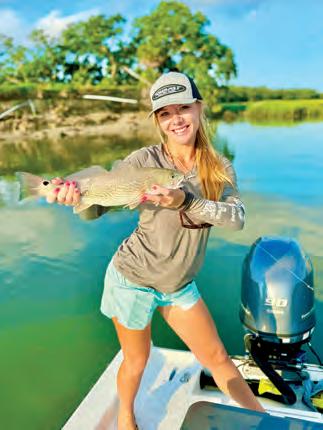
As far as bait goes, the live bait options do go up exponentially from winter/ spring in the creeks & rivers. Which can make catching fish a tad bit trickier. So, I often find using artificial baits to mimic what the fish are feeding on & to cover more ground to be most effective. Also, if you’re able to source the premier live bait options. Such as live shrimp / finger mullet in the Creeks or Crickets / Earth worms in the rivers. You’ll be sure to find the fish!
Best of Luck out there this Summer,


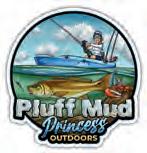
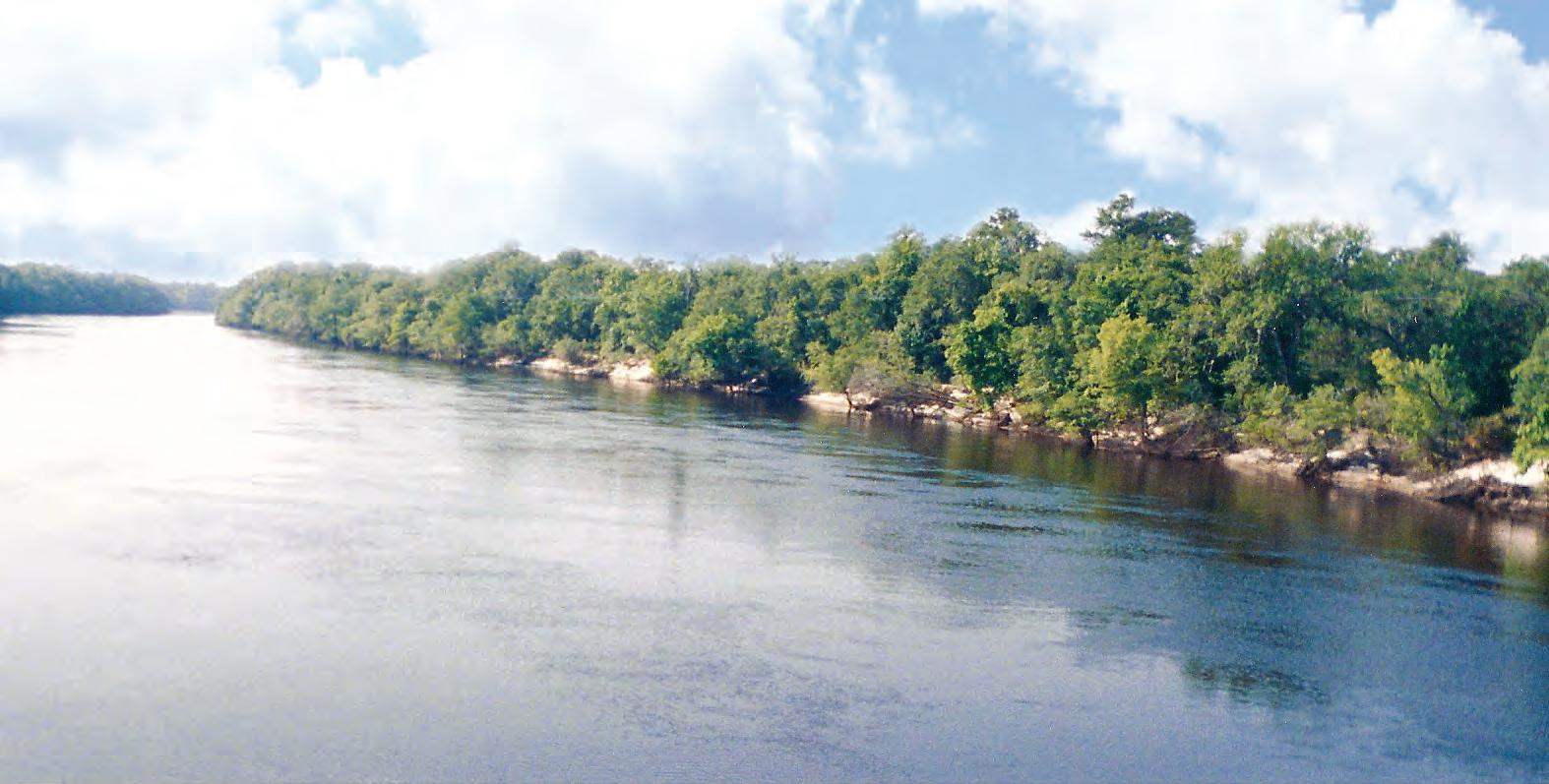
FLORIDA SUWANNEE RIVER WATERFRONT
SALE
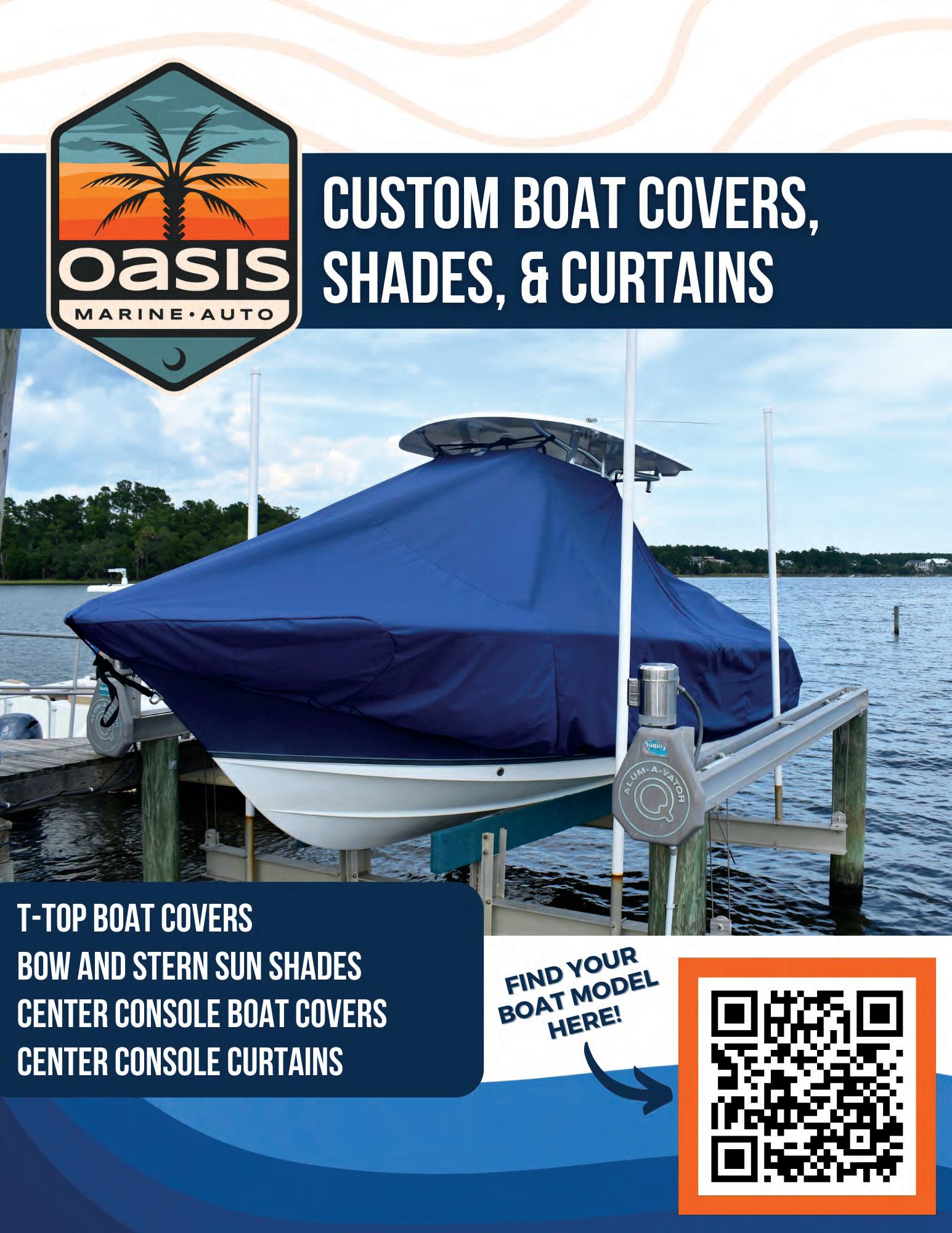

IFolly Beach Pier
by Jacob Cynar, Contributing Writer
f there’s such a thing as a perfect fishing day, chances are it’ll happen in June at the Folly Beach Fishing Pier. If May is the kickoff to the fishing season, then June is the exciting and actionpacked first quarter. Black drum, red drum, speckled trout, and Spanish mackerel are making regular appearances on the pier. Sheepshead and pompano are also getting caught off the pier. One of the most exciting fish to target off the Folly Beach Fishing Pier is the King Mackerel and there is no better time than June to catch them. Many anglers come to pier exclusively trying to catch one of these prize fish. King Mackerel are at the top of their food chains and prey on small schooling fish like mullet, menhaden, and bluefish. On a clear day when the water is flat you may see King Mackerel jumping out of the water in the distance. While there are many ways of catching King Mackerels, at the pier we permit on the trolley rig. The trolley rig is a two-rod system. One rod, the anchor rod, uses a heavy weight keep the line taught so the “trolley” can slide up and down it. The other rod, the fighting rod, has your bait on one end and on the other end is a release clip that goes on the line of the anchor rod. Fishing Pier regulars will use bluefish as their preferred bait. I highly recommend looking into this technique and keeping an eye out for some trolley rigs next time you are out at the Folly Beach Fishing Pier.
While every weekend in June will have plenty of anglers and caught fish, we have two tournaments this month where anglers can test their skills. The first tournament the 14th Annual “Jerry Pierce Memorial” Take-A-Kid Fishing event. This event is June 7th from 9am to 1pm and kids 4 through 16 are encouraged to come! Rods, reels, and bait are provided to the first 250 kids and no preregistration is required. The other tournament is the 2nd one of our CastOff Tournament series. It will be held on June 21st from 6am to 2 pm. Registration happens the morning of the tournament and costs $12 to enter. Reduce tournament fees are available for youth, military, and senior. We have tons of awesome prize packages and even some raffle prizes to give away! For more information visit ccprc.com or give us a call at the Folly Beach Pier: 843-762-9516. May your lines stay tight and your coolers full!
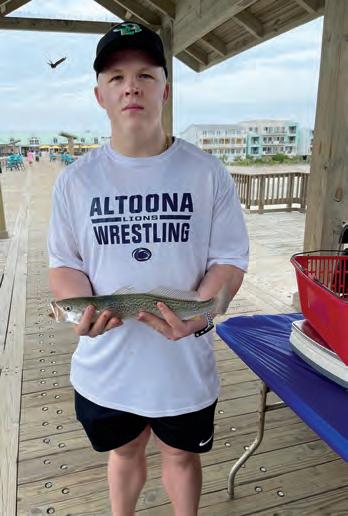
Jacob Cynar, Operations Manager II Folly Beach Fishing Pier 101 E Arctic Ave, Folly Beach, SC, 29439 Office 843.762.9516 Cell: 843.327.0321
Jacob.Cynar@ccprc.com

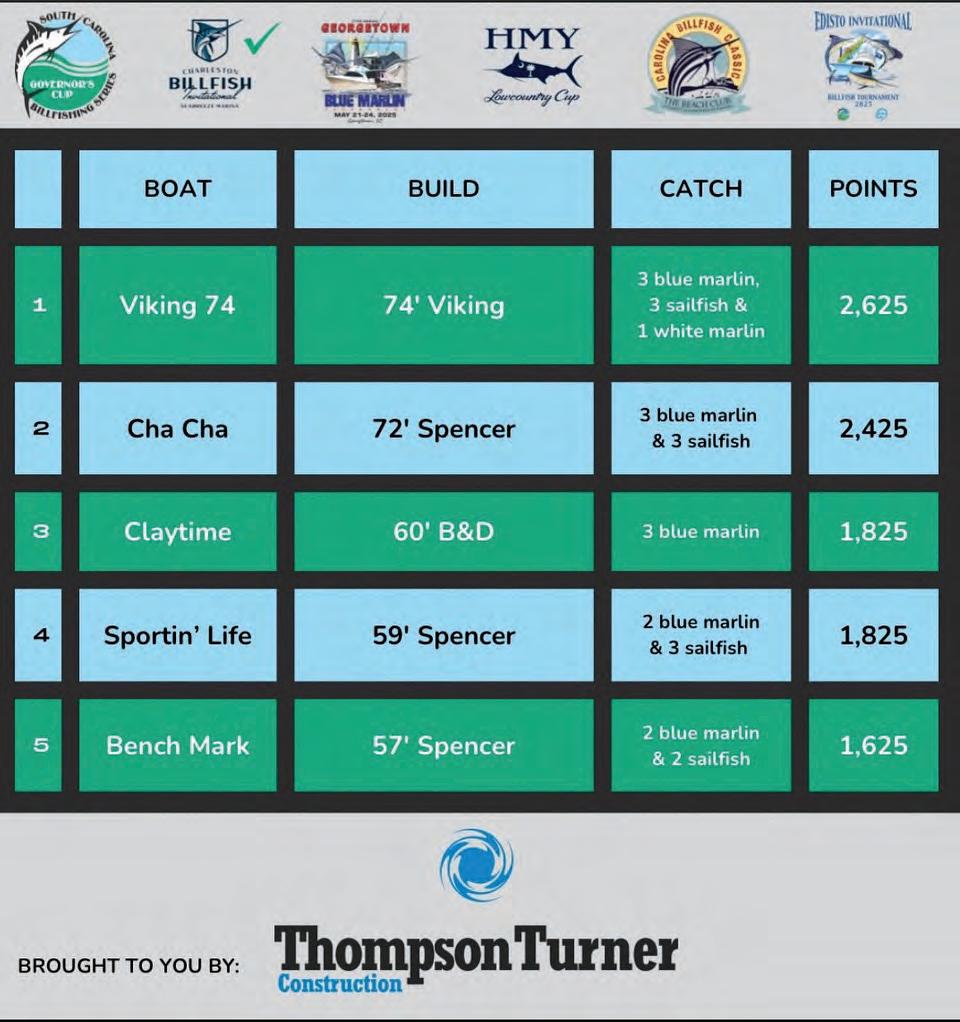
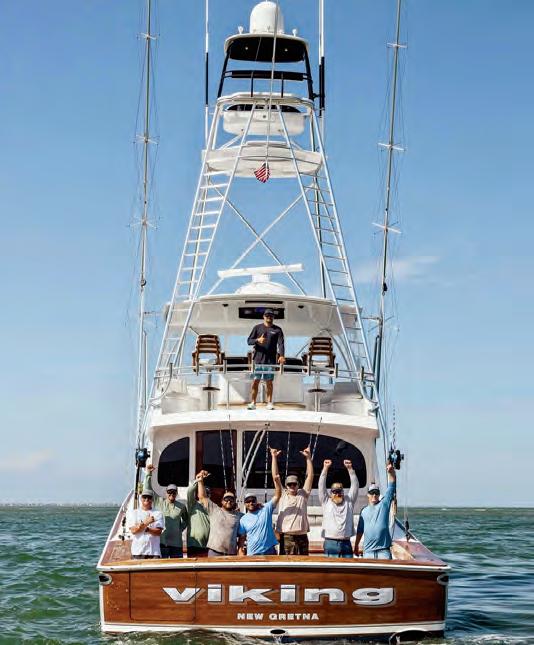
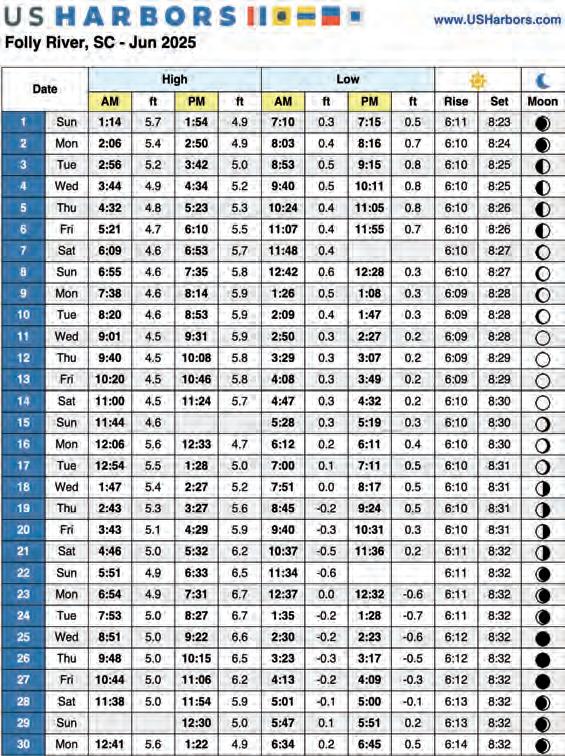
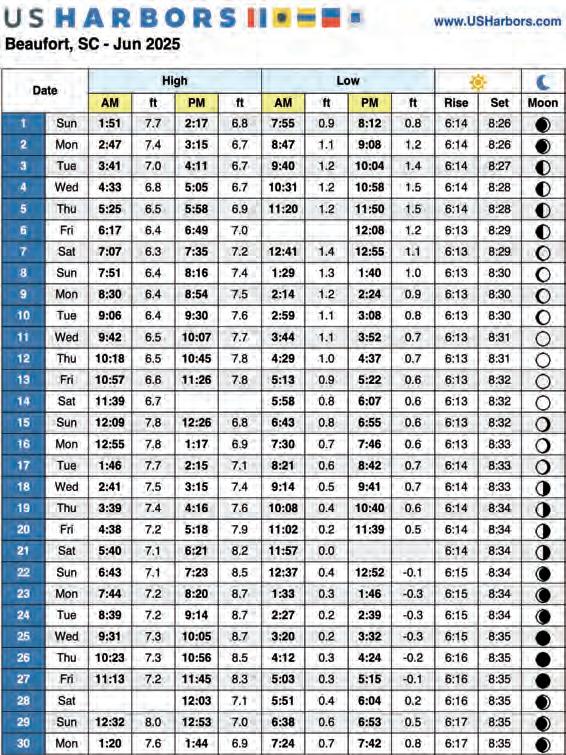
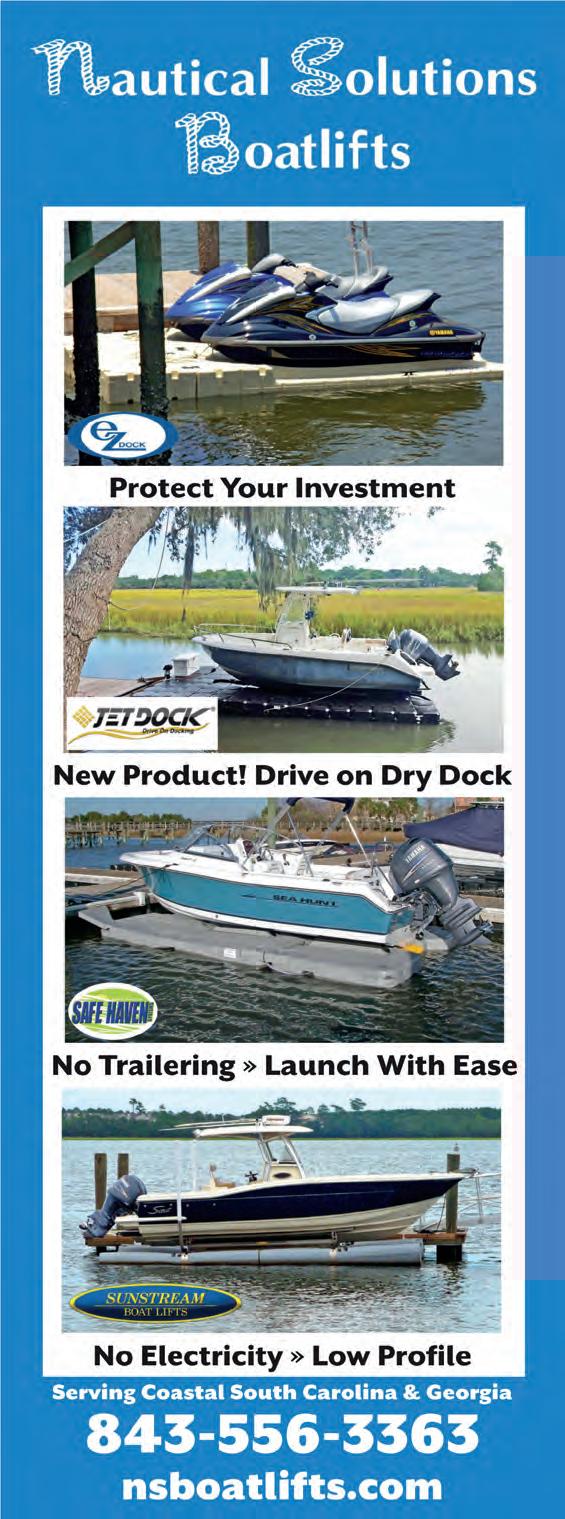
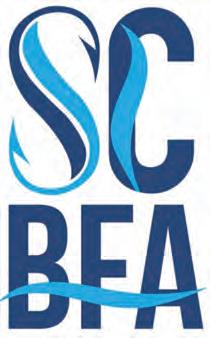
ASC House Subcommittee Unanimously Advances Major Boating Tax Reform
Governor McMaster Announces His Support for Tax Cuts
major bipartisan push to cut South Carolina’s highest-inthe-nation boat property taxes gained momentum today as the House Ways & Means Property Tax Subcommittee unanimously advanced H.3858 to the full House Ways & Means committee. With over 50 bipartisan sponsors, the bill — led by Rep. Gary Brewer (R–Charleston) — would slash property taxes on boats and motors by 50%, delivering long-overdue relief to hundreds of thousands of middle-class boat owners across the state.
“This is a tax cut for working South Carolinians,” said Rep. Brewer. “The current system punishes families who want to enjoy our lakes, rivers, and coastlines. H.3858 corrects that injustice by lowering taxes and ending outdated double taxation on boat motors.”
The effort also received a powerful endorsement from Governor Henry McMaster, who took to X and Facebook Tuesday night to express support: “S.C. boat owners pay the highest property taxes in America. We have a chance to change that. I support cutting boat and motor property taxes so working families can keep enjoying our state’s beautiful waters.”
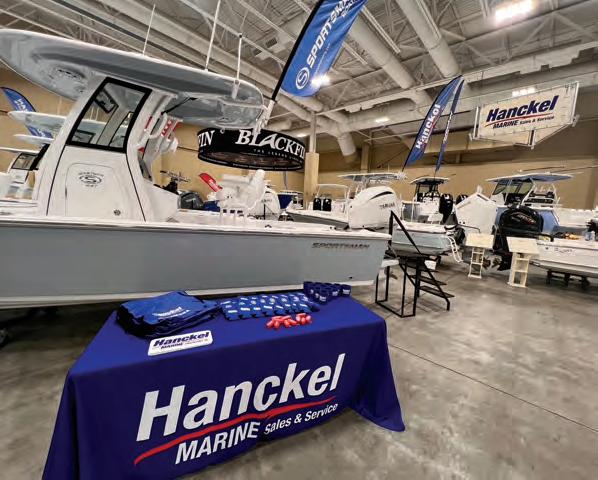
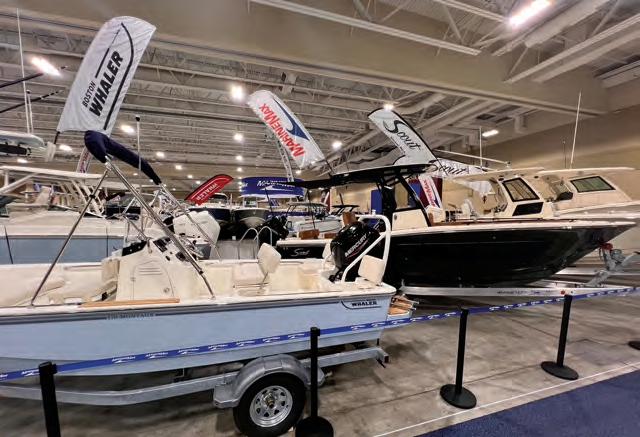
South Carolina currently imposes the highest boat property taxes in the United States — up to 3 to 7 times higher than neighboring states like Georgia and North Carolina. For the same boat on the same lake, Palmetto State families can pay up to $2,800 annually, while a North Carolina neighbor pays less than $400 in some counties.
House Minority Leader Todd Rutherford (D–Richland), a vocal proponent of the bill, added: “This bill is about fairness and freedom. Boating should be about family time, not financial penalties. For too long, the middle class has carried the burden while high-end boats just get registered out of state. That ends now.”
SCBFA dealer surveys show over 78% of boats over $120,000 are registered outside of South Carolina, largely due to the state’s 10.5% property tax rate on watercraft. The result? Smaller boat owners — bass boats, pontoons, and jon boats — are left to foot the bill.
“It’s embarrassing that South Carolina boaters pay the highest property taxes in the country — over three times more than folks in North Carolina and Georgia,” said Rep. Phillip Lowe (R-Florence). “The high tax is a barrier to the average person. I urge every South Carolinian to contact their legislators and encourage them to lower boat taxes.”
Beyond the 50% tax reduction, H.3858 also eliminates the outdated
requirement to title outboard motors, a practice only six states still enforce. This reform streamlines ownership and cuts red tape for boat buyers and sellers.
“This is not a cut for yacht owners or big boat owners — because they just don’t keep [their boats] here,” testified Gettys Brannon, President & CEO of the South Carolina Boating & Fishing Alliance. “We’re being penny wise and dollar foolish on this. We are here for the taxpayer, not for government — and to say loud and clear that boat owners and fishermen in South Carolina deserve better.”
The bill passed with support from subcommittee members Rep. Neal Collins (R–Pickens), Rep. Dennis Moss (R–Cherokee), Rep. Lee Hewitt (R–Georgetown), and Rep. Bill Clyburn (D–Aiken).
H.3858 now heads to the full Ways & Means Committee for consideration.
Lower taxes. More access. More money back in your pocket.
To learn more about H. 3858 or to contact your legislators to express your support for this critical bill, visit the South Carolina Statehouse legislator search tool: www.scstatehouse.gov
Bill Sponsors Include: Brewer, Pedalino, Lowe, Mitchell, M.M. Smith, B.J. Cox, Chapman, Davis, Sessions, Erickson, Guffey, B.L. Cox, Hewitt, Teeple, Hartnett, Pope, Rutherford, Brittain, Wooten, Guest, Hager, J.L. Johnson, B. Newton, Bailey, Bustos, Gagnon, Gilliam, Herbkersman, Holman, Jordan, Lawson, Martin, Murphy, Robbins, Ballentine, T. Moore, Montgomery, Sanders, Atkinson, Ligon, Gibson, J. Moore, Caskey, Moss, Huff, Beach, Terribile, Kilmartin, Hardee, Taylor, and Yow.
Find more information at www.scbfa.com

TFISHING FORECAST
Mount Pleasant Pier
by Chris Pounder, Contributing Writer
ypically in June the harbor temperature reaches 80 degrees and we see a variety of species show up. Expect to see whiting, black drum, sea trout, Spanish mackerel and others get in the mix with the reds, flounder, and sheepshead. June is one of those months that should be great for fishermen of all experience levels.
You don’t have to spend a lot of money to get started. You can get an inexpensive rod combo with 10-20-pound test line and a 2-drop rig or Carolina rig and you’re almost ready to go. This setup is commonly used when pier fishing and the rigs can be purchased in the River Watch Café and Gift Shop on the pier. In order to hold the bottom, you’ll want a 1.5 to 2-ounce weight under most circumstances. One of the biggest mistakes people make around the pier is using hooks that are too big. Keep it simple and stick with a size 1, 2, 1/0, or 2/0 hook. We encourage the use of kahle or circle hooks when possible as these offer a better chance for the safe release of fish that will not be kept. Now you just need some bait and a daily fishing pass from the shop and you’re ready to fish.
When it comes to bait there are many choices, and some work better than others on any given day. Frozen shrimp on a bottom rig is the most common bait and our top seller by far. When putting shrimp on the hook, you’ll want to cut it into smaller pieces and remove the shell. Removing the shell sounds counterintuitive, but it releases more scent into the water and the bait will stay on the hook better. A fishing buddy once said that elephants eat peanuts and there’s definitely truth to that. Leaving chunks hanging off the hook will allow baitfish to pick you clean and soon you’ll be fishing on credit. If you want live bait, you’ll want to stop off and visit our friends at Haddrell’s Point Tackle and Supply or bring a cast net to catch your own. It’s best to check out the pier at low tide before throwing a net so you’re familiar with where the rebar from the old bridge is located.
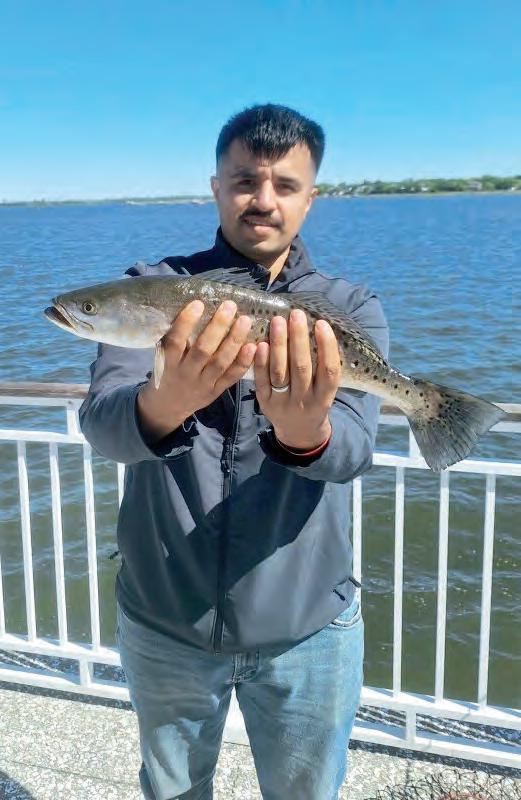
For any additional information about the pier or what’s biting this week feel free to call the River Watch Cafe & Gift Shop on the pier at 843-762-9946
Chris Pounder, CPRP Manager Mount Pleasant Pier
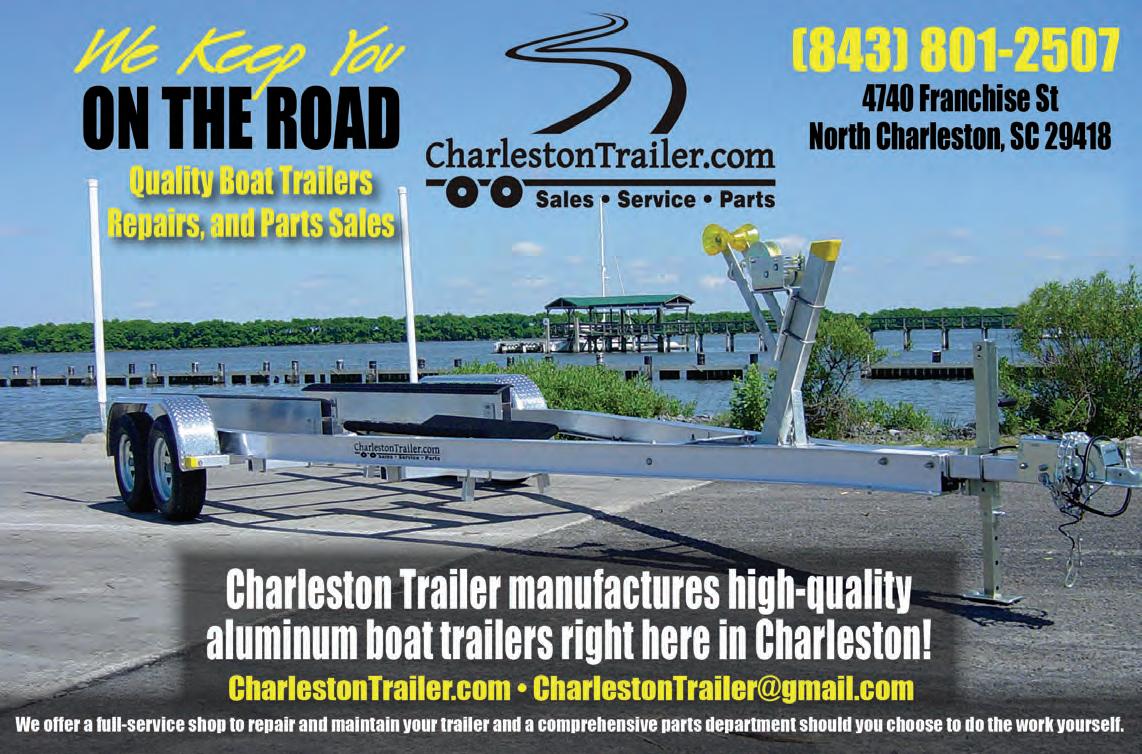
Juan with a nice trout
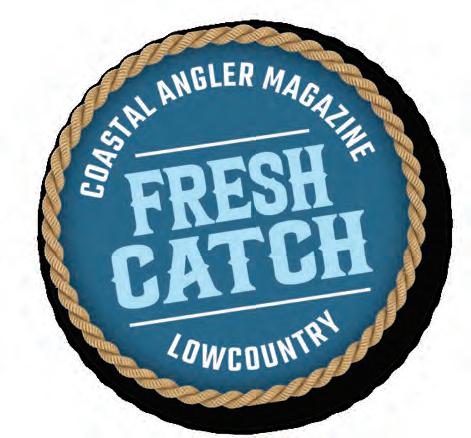
Jake Harmon caught this 13lb 2oz Blueline Tile in Charleston, SC. with grouper complex season open, we pushed deep and pulled up this beauty from 600 foot

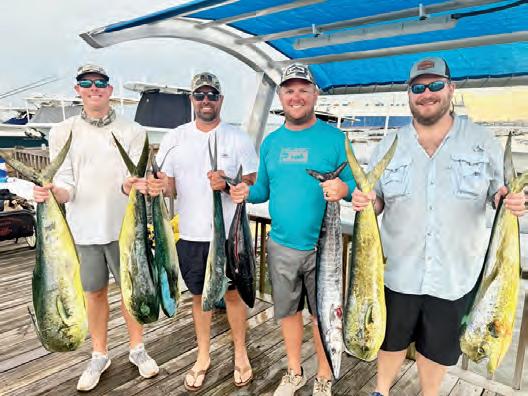
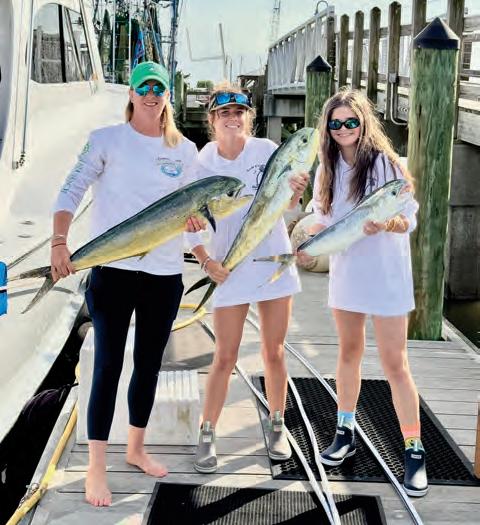
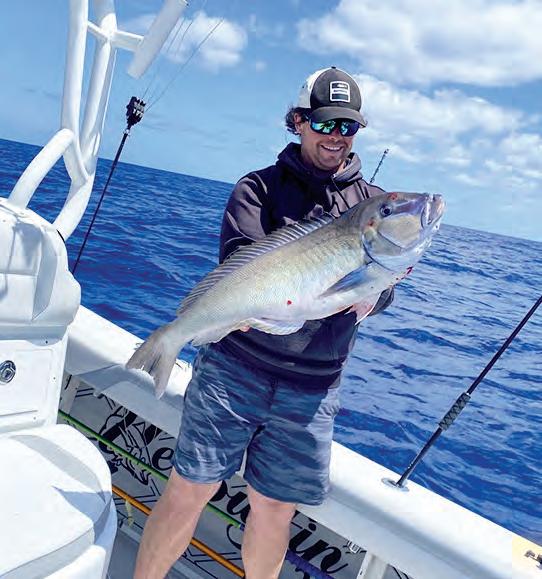
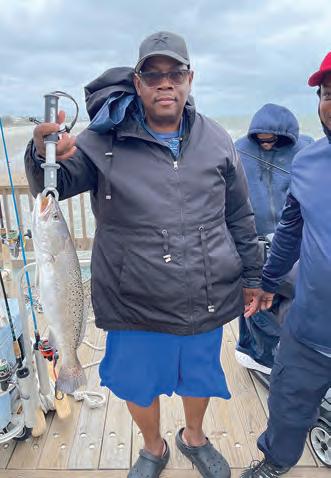
Shots from the first Cast Off Tournament at Folly Pier, May 10th.
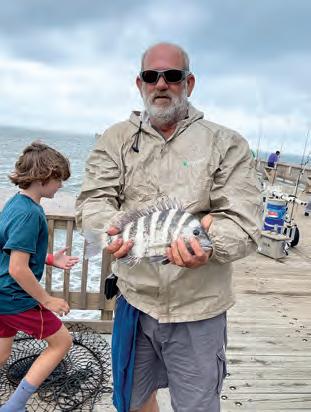
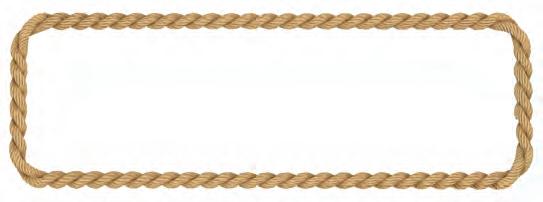
Louis Howell and Gang from Lowcountry Mahi Invitational
The Gorin Girls from the Lowcountry Mahi Invitational









GO DEEP(ER)
Tim Barefoot
I’ve written quite a few articles on the tactics I used to catch grouper on the edge and inside the edge with bait in a decoy jig in the past, but now is a good time to push out a little further to see what’s up in the 350 to 500+ foot depth range. !is type shing may require you to change gears on your thought process and/or tackle, but you may be pleasantly surprised with the results.
First o , you will want to use a spinning rod with backbone and a lighter braided line. I’m not going to suggest any tackle manufacturer for rod, reel or line, but the line in the jig is the most important part of this equation. I know this sounds crazy, but you can get away with braid, a small is 20 pound test connected to a short 6-foot shot of uorocarbon leader, and catch the big boys from the deep. When you sh ledges, wrecks and rock homes, you have to use heavier tackle to coerse the grouper and big snapper out of the structure, but in the deep the sh tend to congregate around bait, and there is very little structure out there for them to get you in. !e bait out there consists primarily of squid—the universal bait for all the seven seas of this planet, period. Squid are present at all depths, from the surface at night to their migration back to the deep by day; just ask any sword sh. Ha!
!is deeper water shing may also require a change in electronics. In order to mark the sh and bait you need to have enough power to send the signal and

get a return. You can run all over creation trying to mark sh or bait in vast areas of water, but having the correct electronics will assist in this greatly. Once you start marking the blue-speckled screen on the bottom, you know you’re in squid. I’ve always said it, but when you nd the bait you found the sh. Once you mark the bait, more than likely, it will be squid and it’ll be time to drop in the correct jig.
I’ve made several videos using the 4 ounce (so plastic) Squid Jig, but I’ve also had a 6 oz. size made. A 10 inch mold cra ed squid, trimmed properly, can be very e ective at times. Fish like a champ on the 6 ounce headed down deep. !e jig stays perfectly horizontal and jumps like the 4 ounce, and everything down there sucks it up. I’ll be publishing videos soon on this.
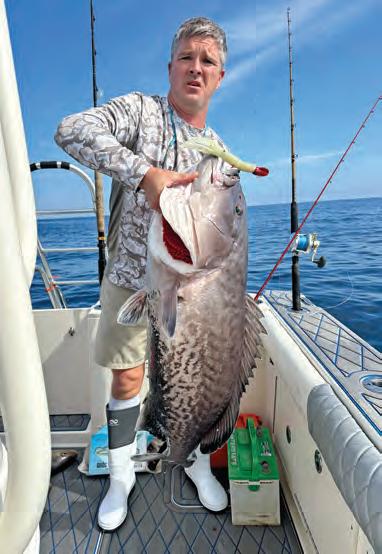
I’ll close with this: nd the bait and you’ll nd the sh...using the correct electronics. Once you nd the bait/ sh, drop in the correct jig that imitates what they eat on a daily basis and you’ll get the bite. And one more very important note. Pay close attention to the MPAs, which are marine protected areas, and seasons you can sh in them. You need to be well informed of where you are when you nish shing and what you could put in the cooler. You have to play by the rules.
Check out Tim Barefoot’s YouTube channel and website, barefootcatsandtackle.com.
CAST LURES IN A MITZI TOURNAMENT 17
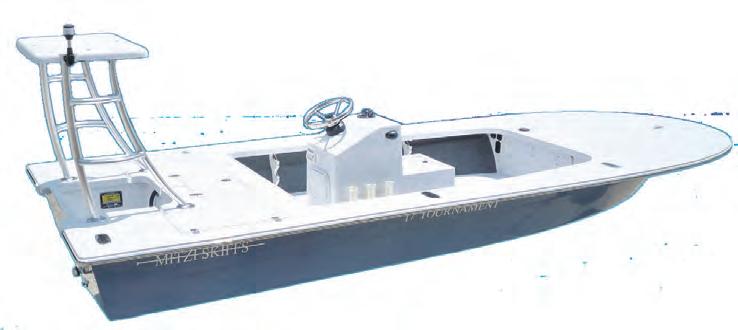

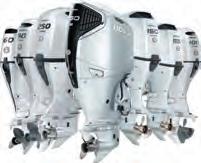
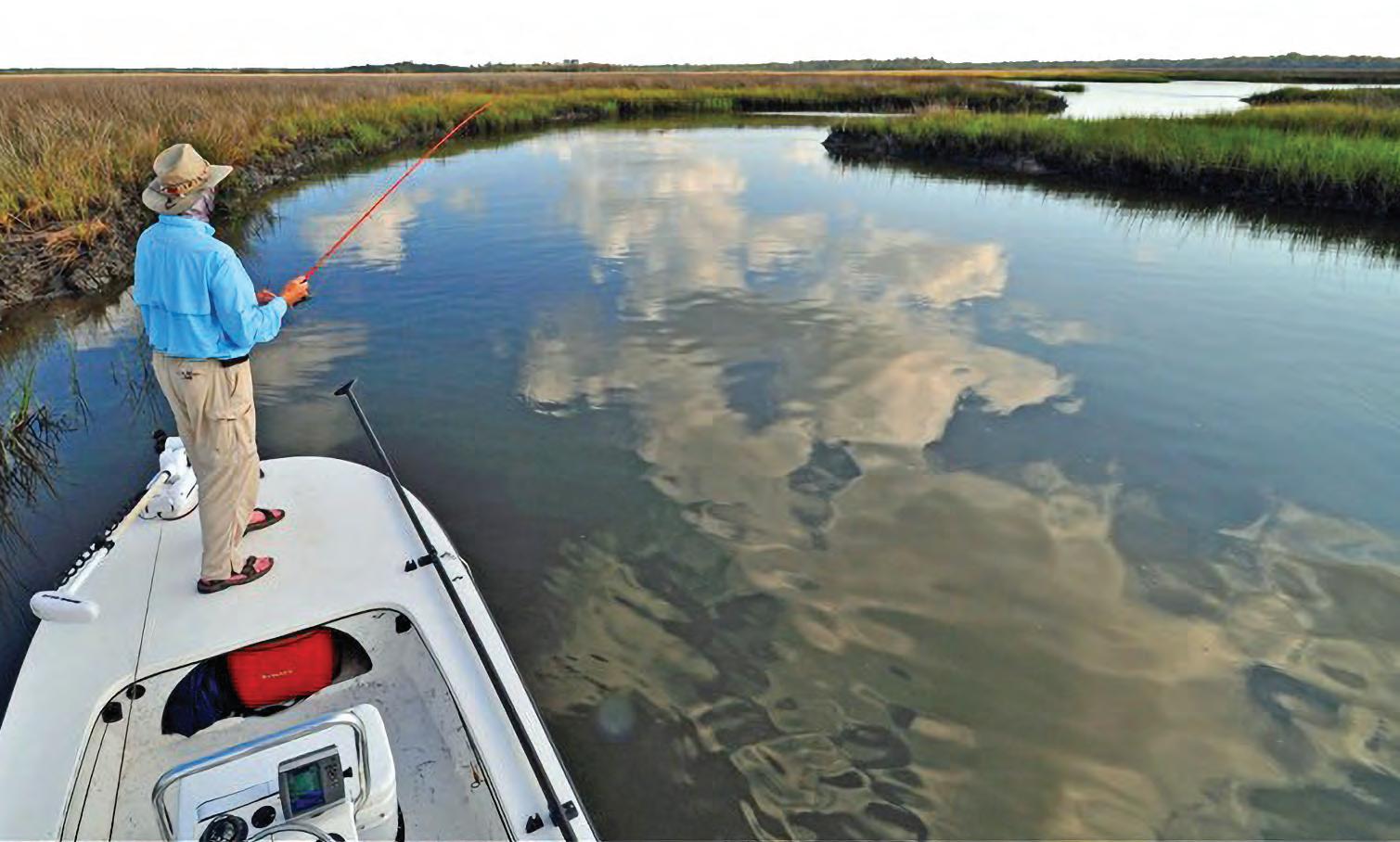
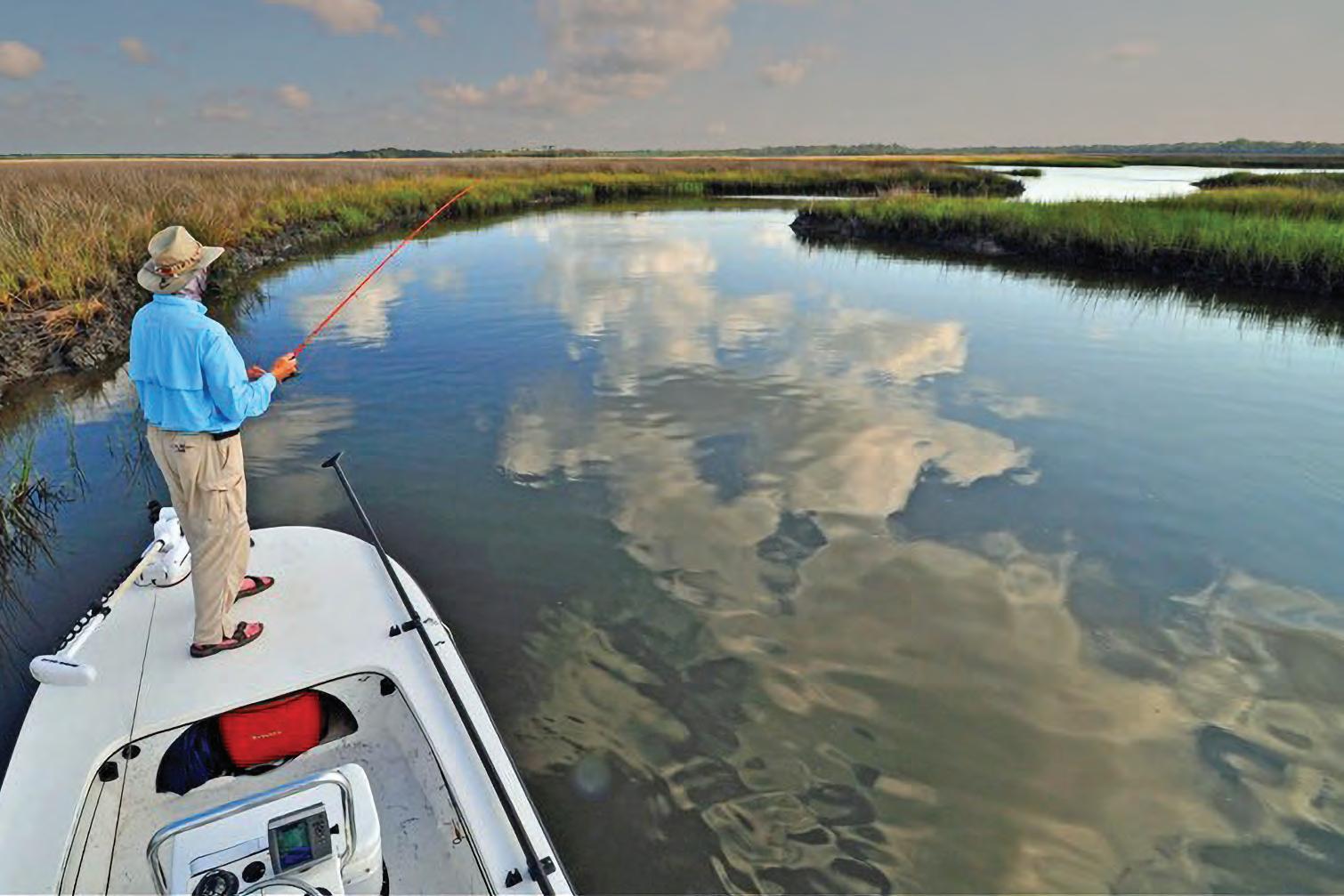
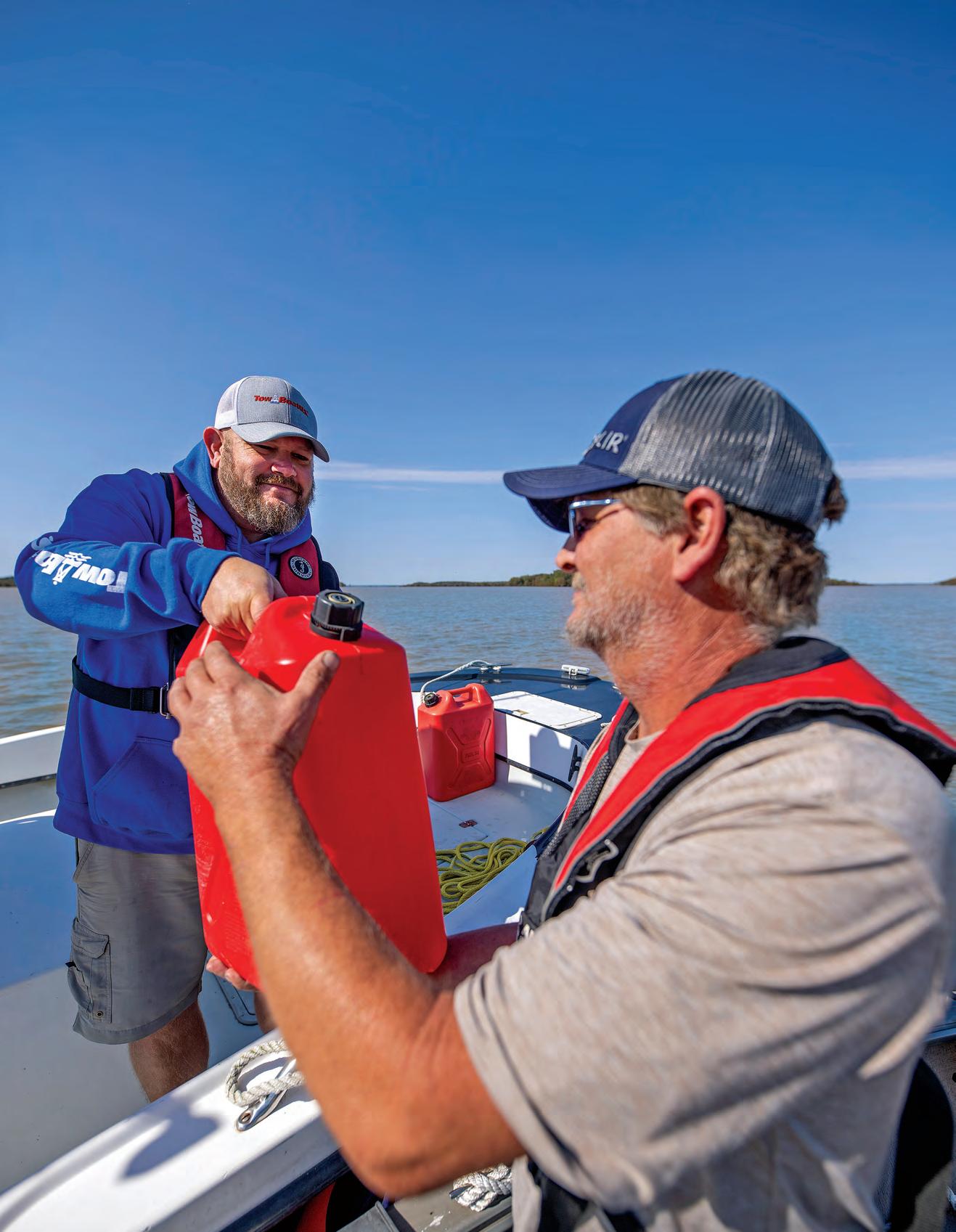
EMPTY TANK?



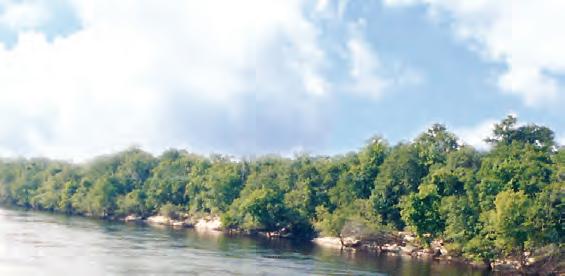
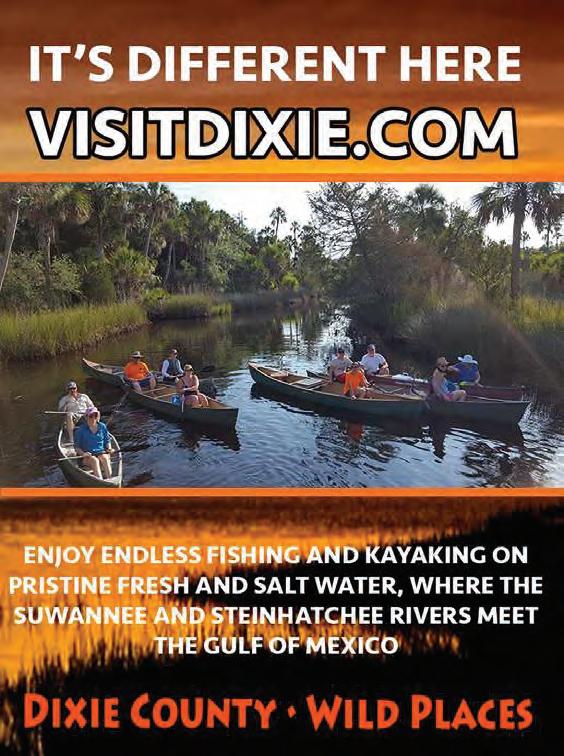


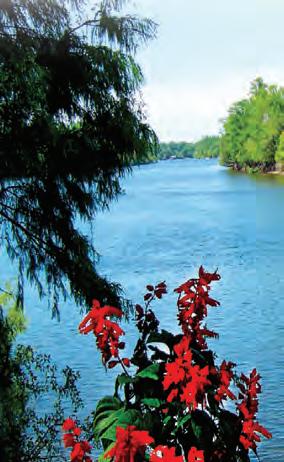
TIPS FROM A PRO
FISHING A BIG WORM
hile there are many ways to target bass, one method consistently stands out— shing with a big worm.

Worm shing may not be the ashiest technique, but it allows you to present your bait from a distance and work it slowly—ideal for tempting big, cautious females that ignore faster presentations.
One of my go-to techniques is casting a Texas-rigged stick bait. It’s a common tactic, but many anglers waste time casting at dead water. I focus on high-percentage areas, such as isolated patches of grass or lily pads. Even when the sh aren’t visible, they o en hold tight to this type of cover. Similar results can be achieved by targeting wood or rock. Make multiple slow retrieves through these areas for best results.
I prefer a larger 6” stick bait in dark colors like black and blue tip. For weights, 1/16 or 1/8 oz keeps the presentation subtle and natural. I recommend 17–20 lb uorocarbon, which o ers strength without sacri cing stealth—braid can be too intrusive here.

To cover more water and locate active sh, I switch to a big speed worm. While it’s a popular technique in Florida, where I predominantly sh, it works well across the country. !e bait’s vibration drives bass crazy, making it an excellent search tool. Once I nd sh with this method, I slow down and ne-tune my approach with other techniques. For stained water, I like darker colors like junebug; for clearer water, I use green pumpkin with ake. Weight ranges from 1/8 to 1/4 oz depending on depth and wind. Fluorocarbon in the 15–17 lb range is ideal here too.
Another e ective presentation is the wacky rig. It’s a more subtle approach and shines in pressured waters. Like with the Texas rig, I cast this bait weightless to isolated cover. I use lighter line and a spinning setup—typically 10–15 lb leader—adjusting based on cover density. In dirty water, I stick to dark colors; in clearer water, I go with more natural tones.
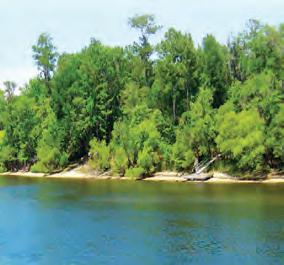



Flipping a worm is another technique I use, especially when there’s a lot of heavy cover. While not as stealthy, ipping allows you to place the bait precisely where other rigs can’t reach. I use large Senko-style baits, braided line, and heavier weights (3/8 to 3/4 oz) to penetrate thick vegetation. It’s perfect for pads, long banks, and heavy wood or grass. !e key is to sh slowly and thoroughly, putting your bait where others haven’t.
Rod and reel setups vary slightly depending on the technique. For most casting and ipping styles, I like a longer rod—around 7’6”— with medium-heavy to heavy action. !e 13 Fishing Omen Series has a few ideal models. I pair these with a high-speed baitcasting reel like the Concept A 7.5:1, which helps pull sh out of thick cover quickly.
For the wacky rig, I downsize to a 7’3” medium-heavy spinning rod. It o ers enough backbone to move sh but also provides the sensitivity and exibility needed when using lighter line. A spinning reel with a smooth drag is crucial. I recommend the 13 Fishing Axum, which o ers the control and power necessary for nesse shing around cover.
!ese worm shing techniques consistently produce. Whether you’re casting to isolated cover, ipping into thick vegetation, or working a speed worm through open water, there’s a big bass out there waiting to bite. I’m excited to put these methods to work—and hope they help you land some giants too.
Tyler Woolcott is a professional tournament angler and guide. Check out his website at www.tylerwoolcott shing.com.
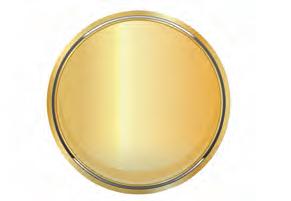

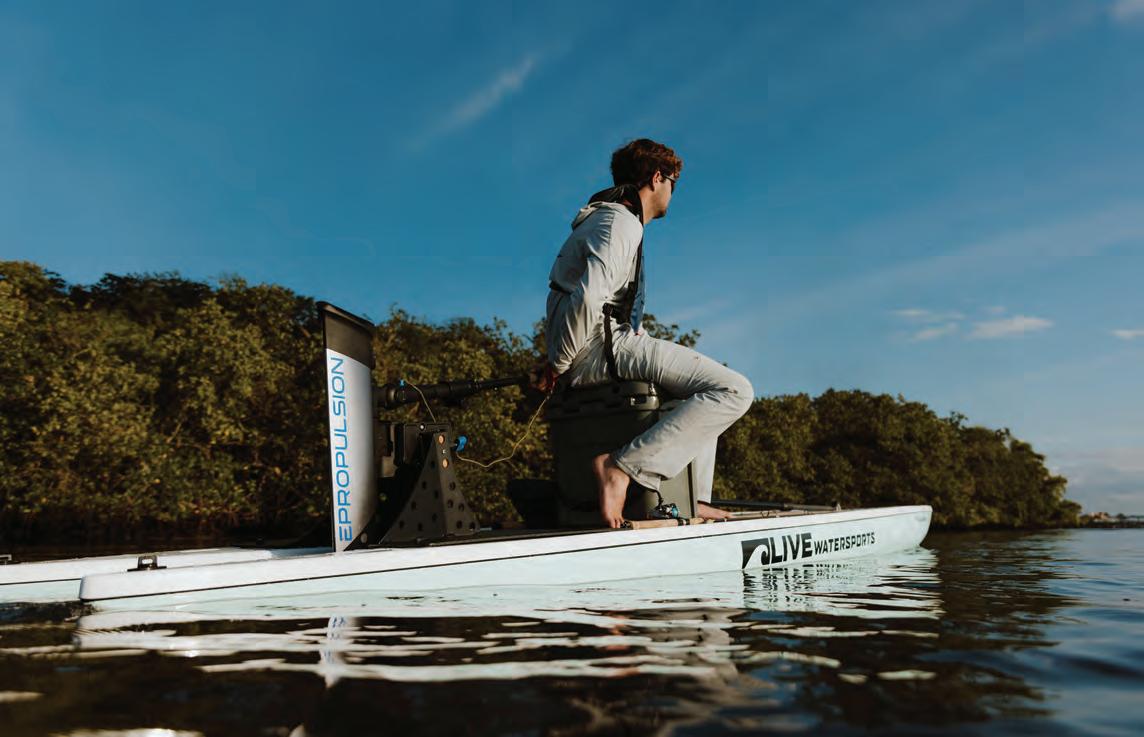





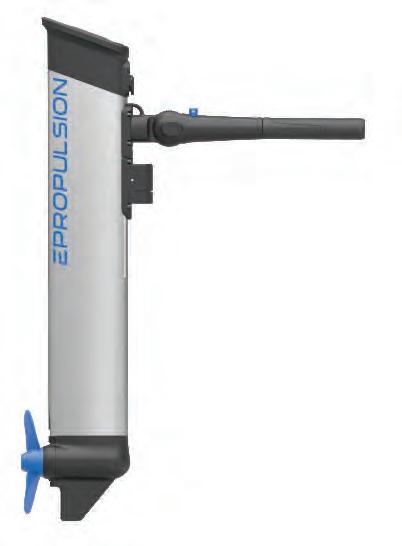
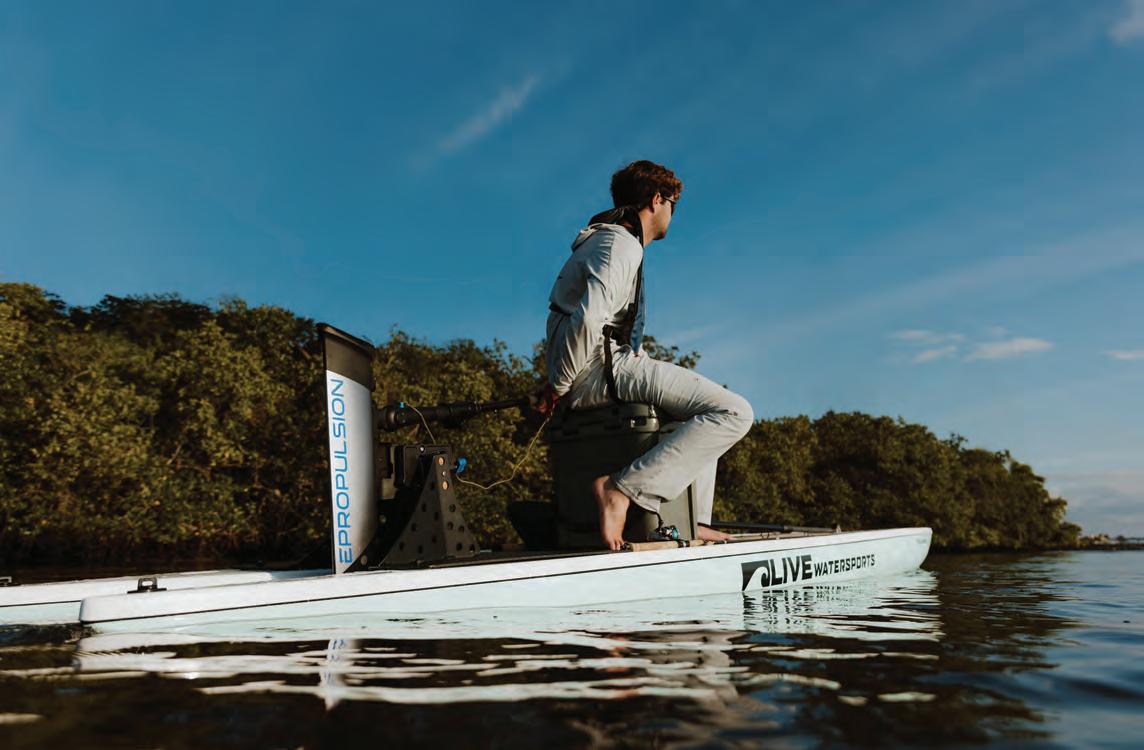




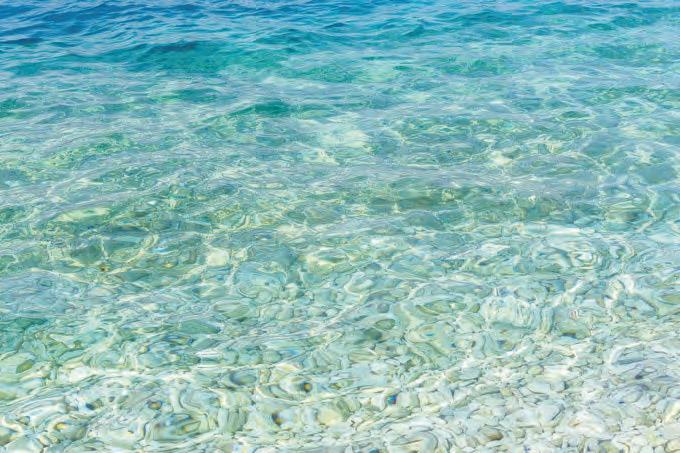




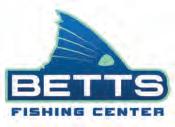

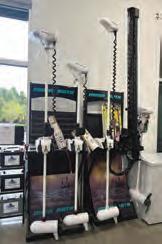
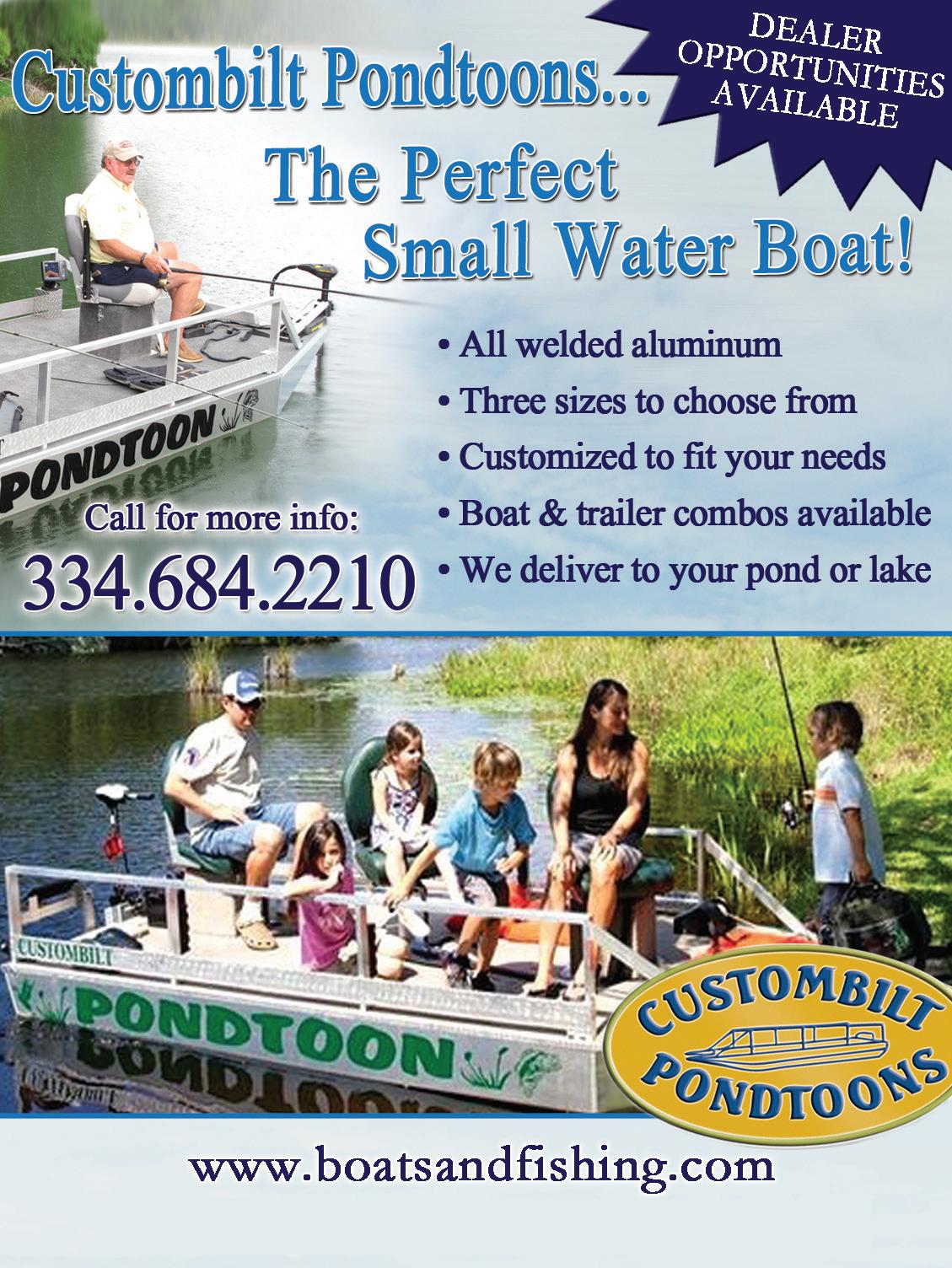
WHY BUY NEW WHEN YOU CAN RENEW?!?

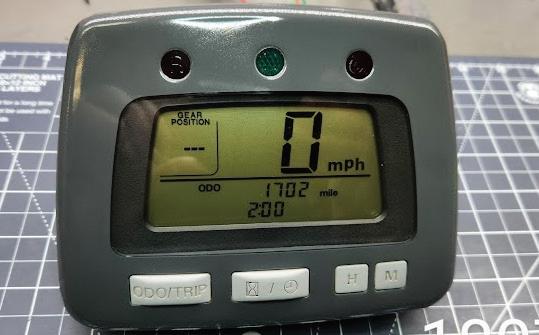
STATE RECORD FISH TITLE BROKEN THREE TIMES THIS YEAR!
For the third time in less than a year, Georgia has a new freshwater !sh state record spotted sun!sh!
Josh Forsythe of Homerville, GA (Clinch County) landed the newest record catch of 0 lb, 13 oz on May 5 from the Suwannee River. is almost 9-inch catch beats the previous state record tie of 0 lb, 12 oz, according to the Georgia Department of Natural Resources’ Wildlife Resources Division (WRD).
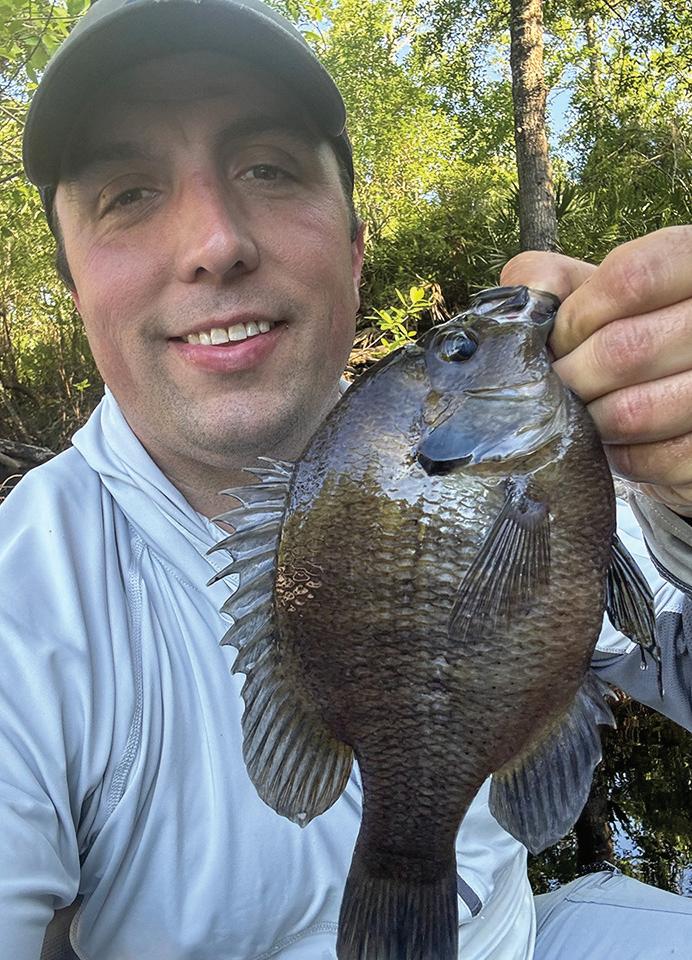
“My 5-year-old daughter and I were !shing for bream on one of my favorite rivers, the Suwannee, when I caught this spotted sun!sh,” said Forsythe. “I have been !shing this river for more than 15 years and it is one of my favorite places to !sh for good-sized bream, especially spotted sun!sh. I recommend waiting until river levels are below 4-foot and using top water bugs to catch giants, but a beetle spin or even a cricket or a worm on a cork will work.”
Spotted sun!sh are found in the Ocmulgee, Oconee, Altamaha, Ogeechee, Ochlockonee, Suwannee, St. Mary’s, Satilla and Savannah River basins. When angling for them, WRD recommends using worms, crickets, small spinners, ies and popping bugs.
“Maybe hearing about that state record tie for spotted sun!sh !red up some folks to land a new record – and we love to see it,” says Scott Robinson, WRD Chief of Fisheries. “Are you the next state record holder? Georgia has the best variety of angling opportunities across the state so Let’s Go Fish Georgia!”
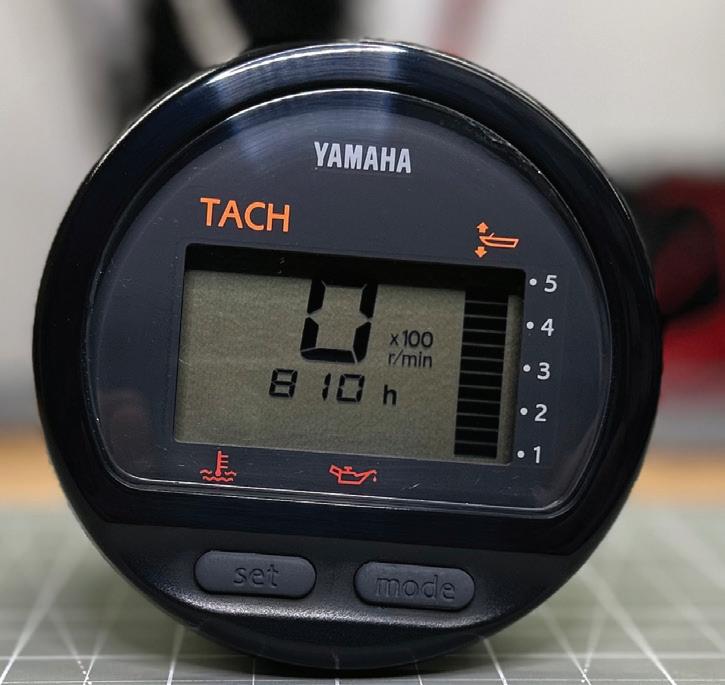
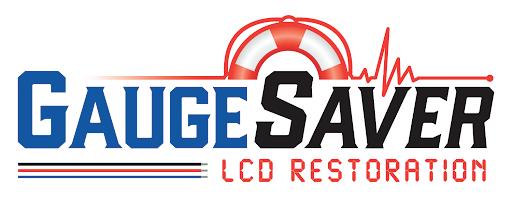
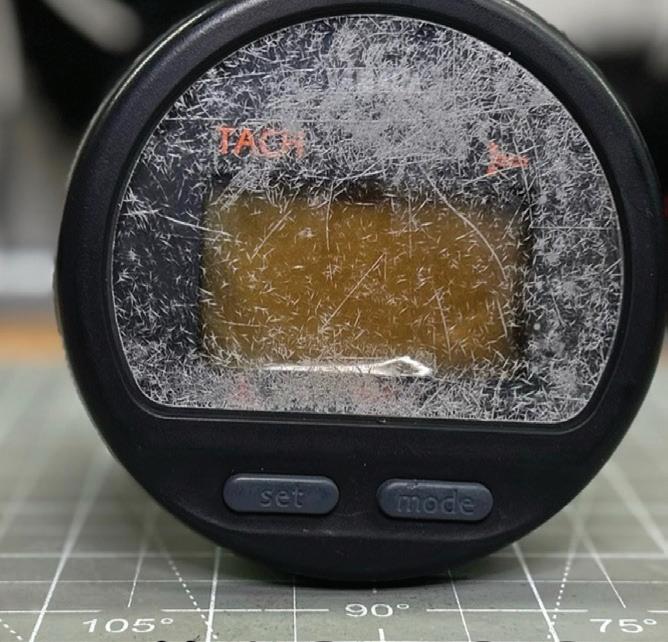


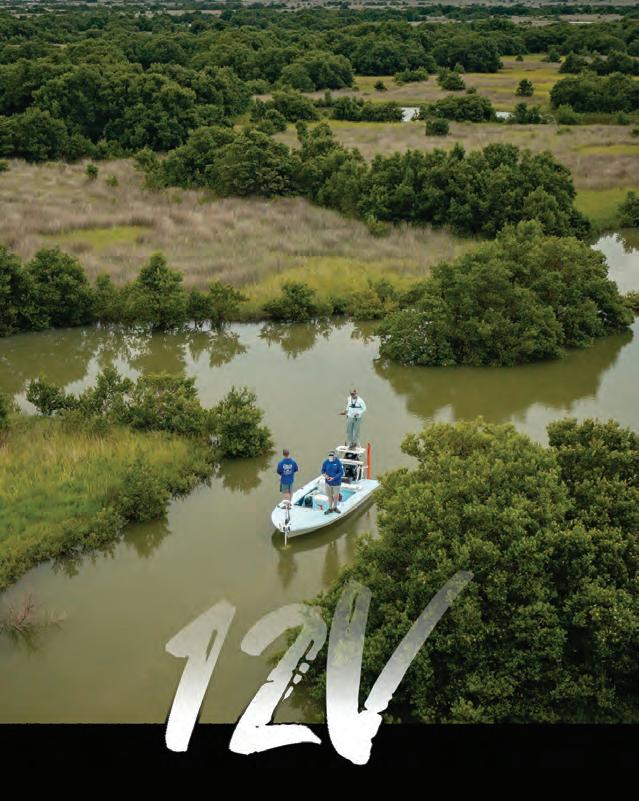
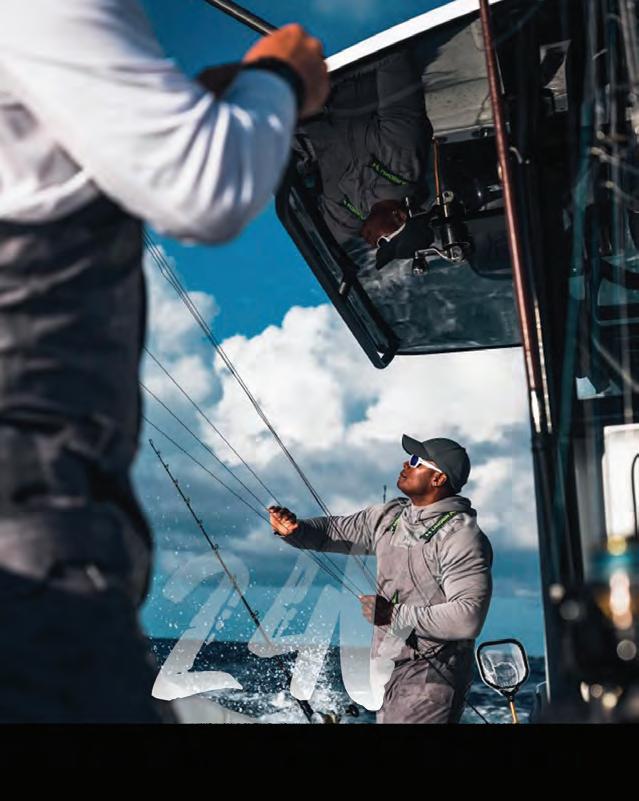



NC CERTIFIES NEW VERMILION SNAPPER RECORD
North Carolina‘s Department of Environmental Quality’s Division of Marine Fisheries recently established a new state record for Vermilion Snapper (Rhomboplites aurorubens).
Colby Shaw of Newport caught the 7-pound, 4-ounce sh o Morehead City on April 18, 2025. !e previous state record was 6-pounds, 9-ounces landed out of Ocean Isle in 2009.
Shaw was shing in his own vessel, o shore south of Beaufort Inlet when the sh struck his cut bait. Shaw made quick work of reeling in his state record sh, landing it using his Shimano rod and reel with 65-pound braid.
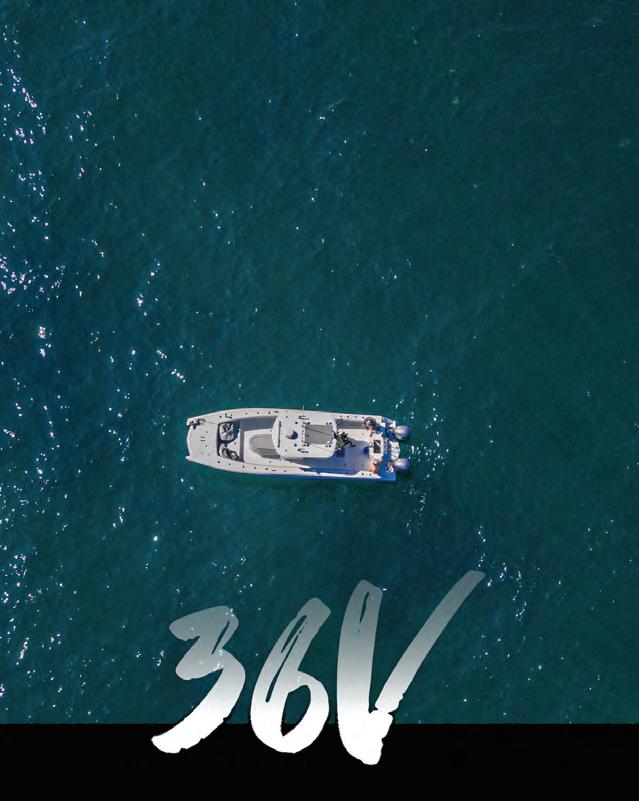



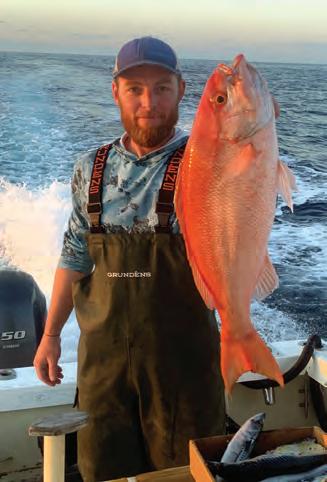
Shaw’s sh measured 23.5-inches fork
to the fork in the tail) and had a 17-inch
sheries sta at the Morehead City Headquarters
!e
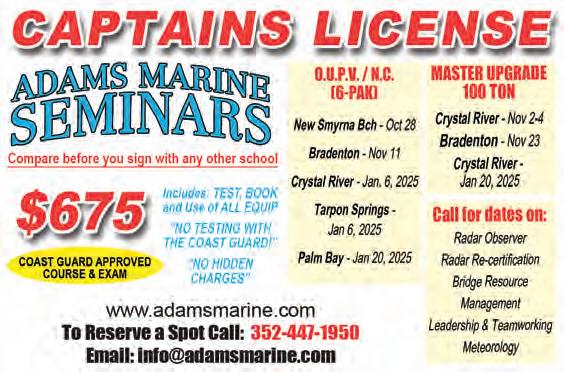



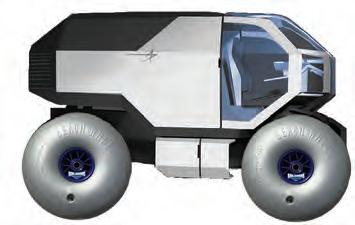

Division of Marine Fisheries.
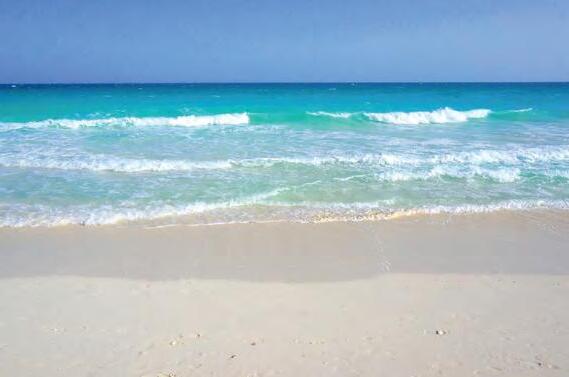








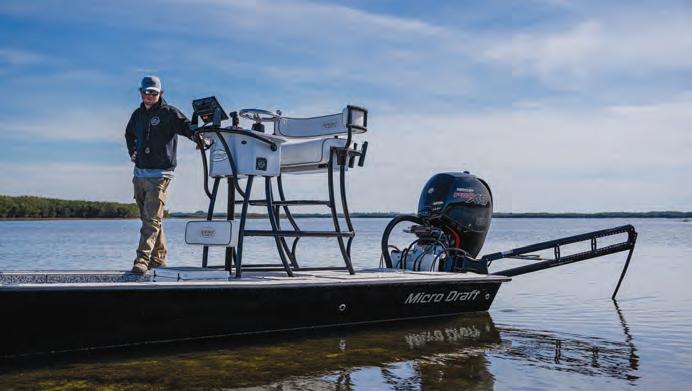




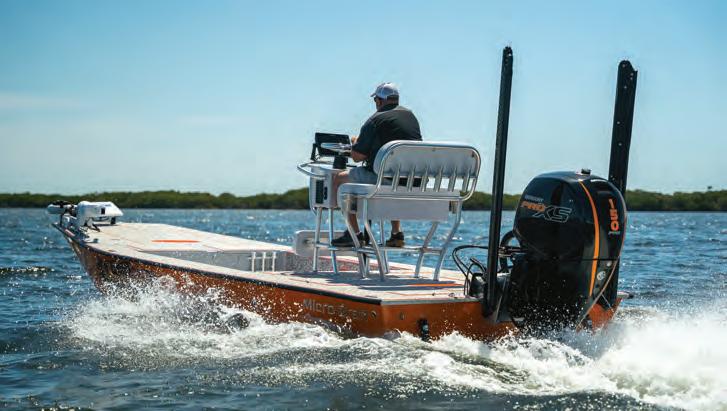

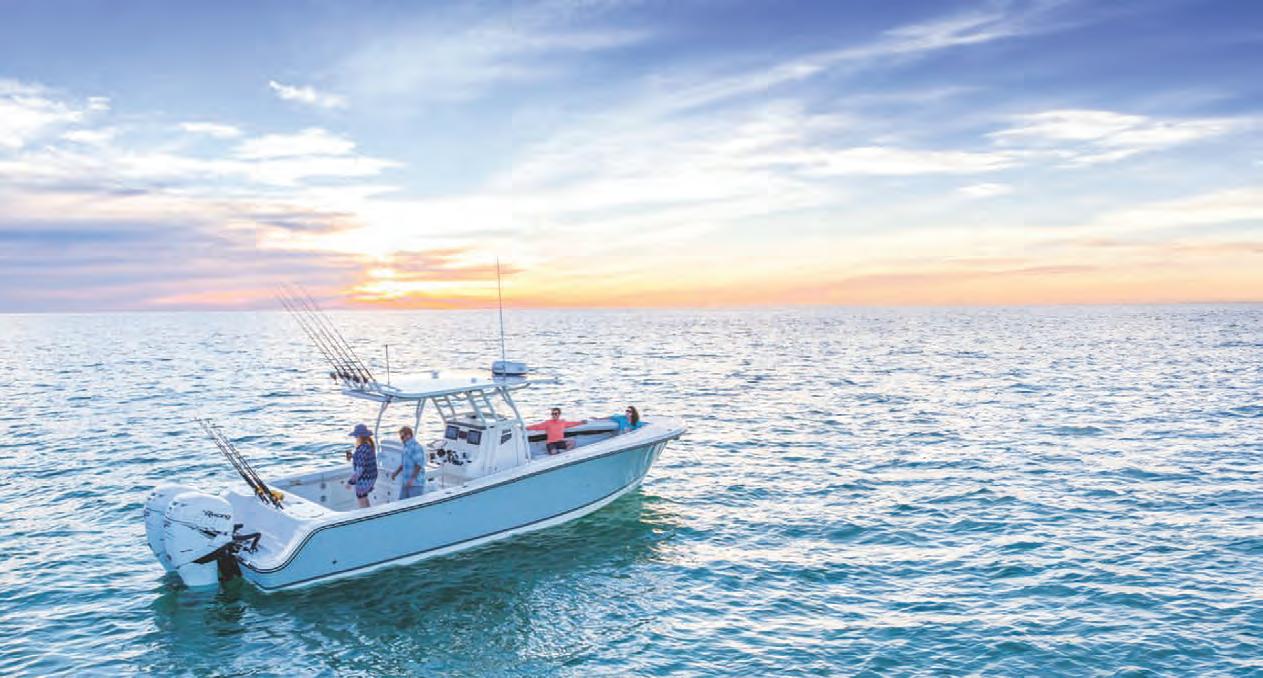


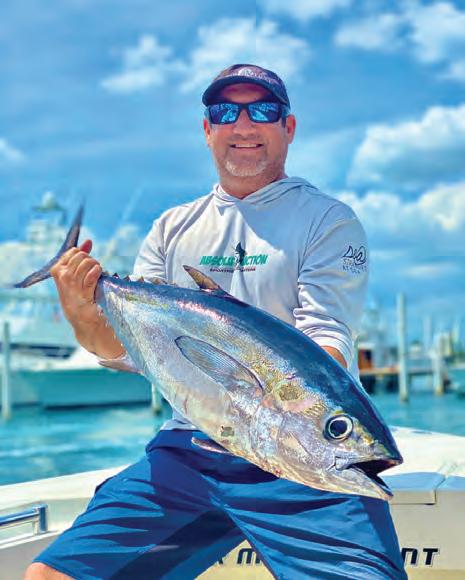



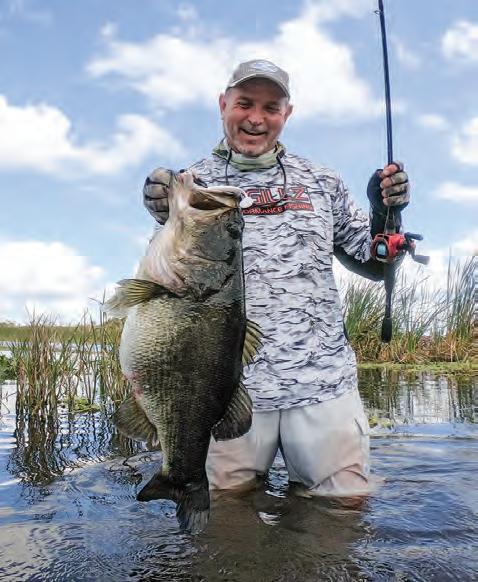

Bill Dance Signature Lakes O er Impactful Improvements to Tennessee’s Fishing Waters
By David Haggard & Heather Lose
Representatives from Tennessee Wildlife Resources Agency, Tennessee Department of Tourist Development, and Tennessee State Parks celebrate the ribbon cutting of the Bill Dance Signature Lakes project at the Bassmaster Classic in Knoxville on March 25, along with the project’s namesake. Photo Courtesy of the Tennessee Department of Tourist Development:



